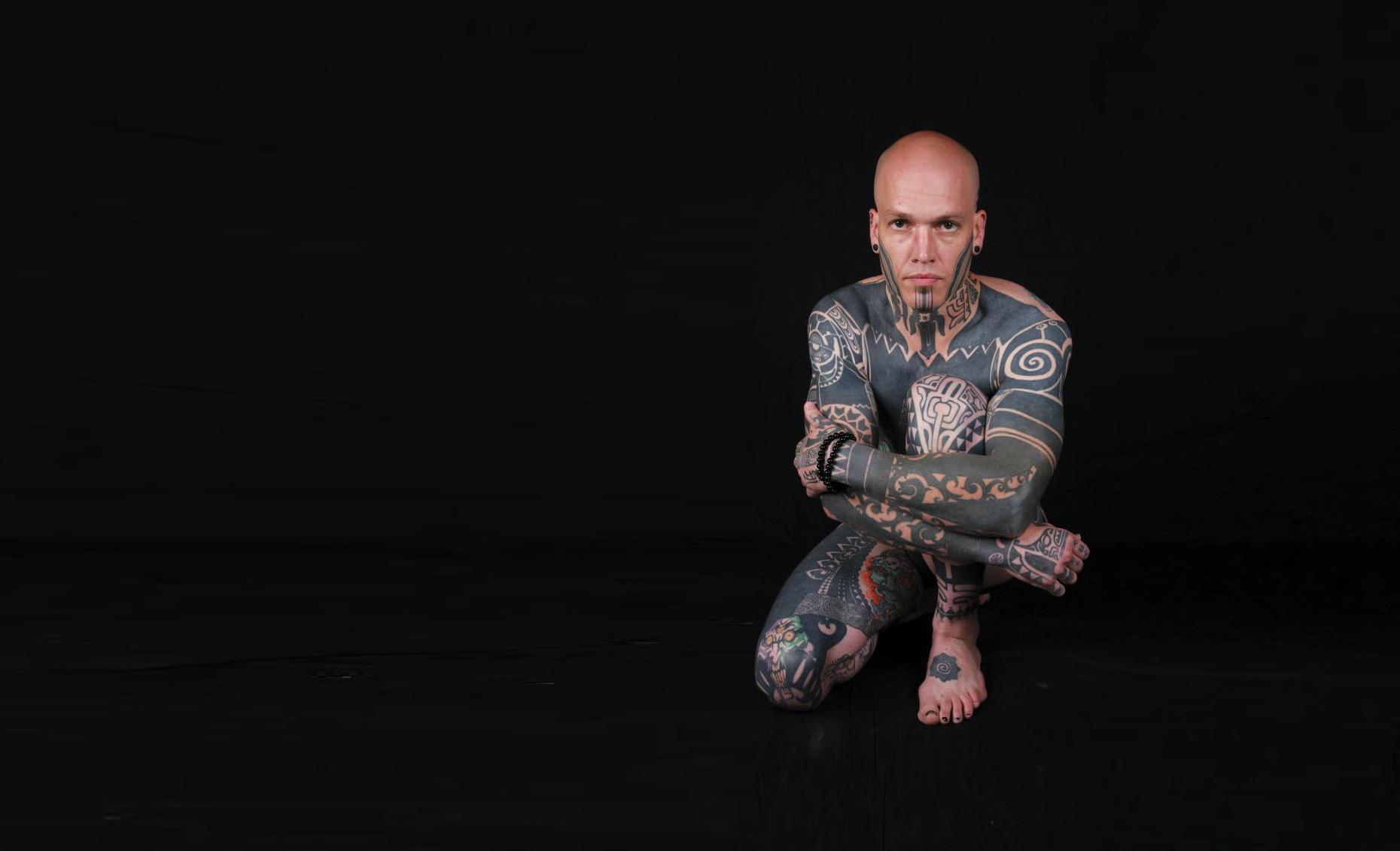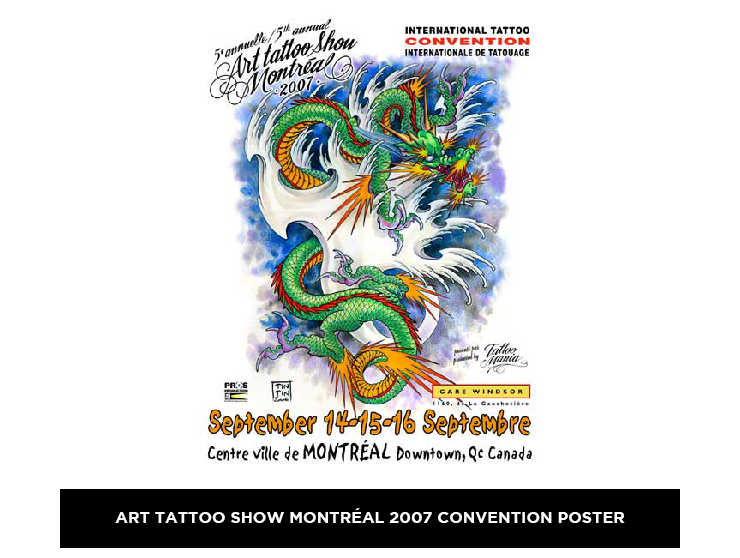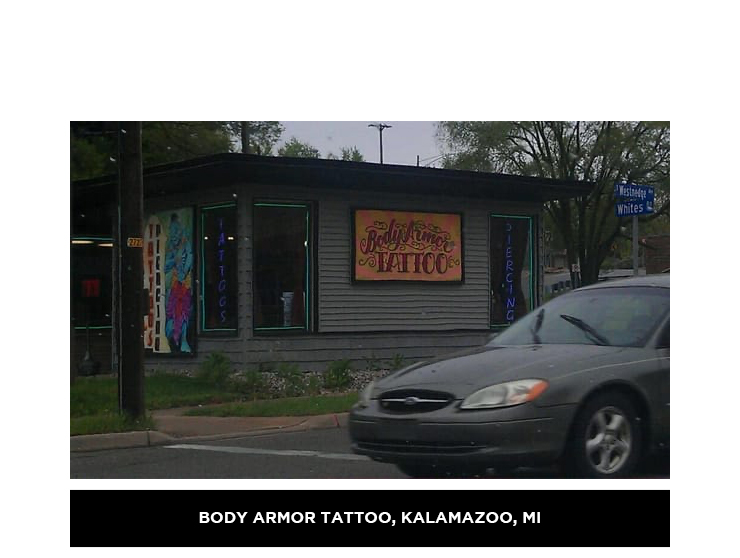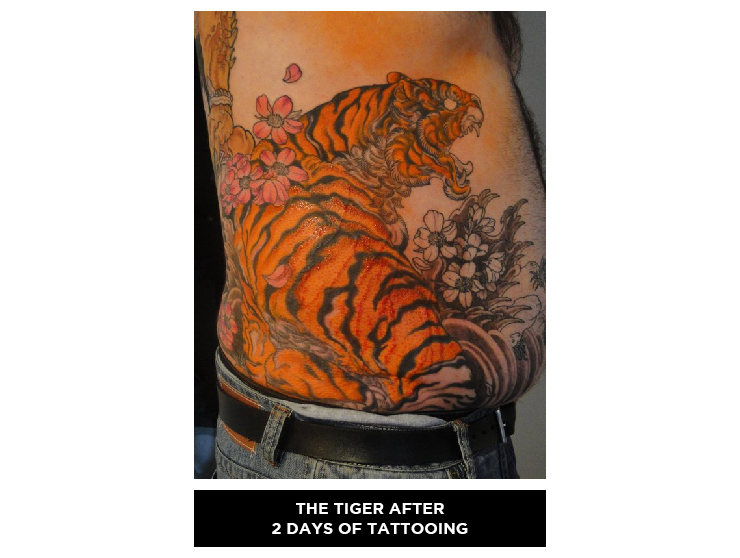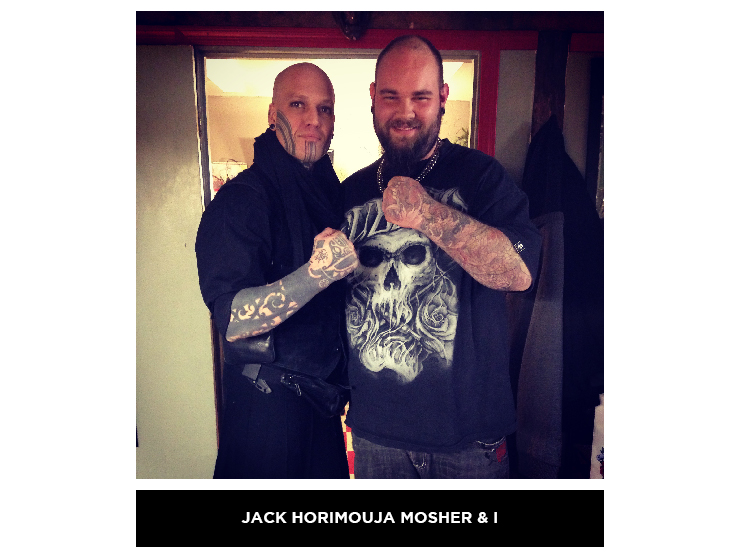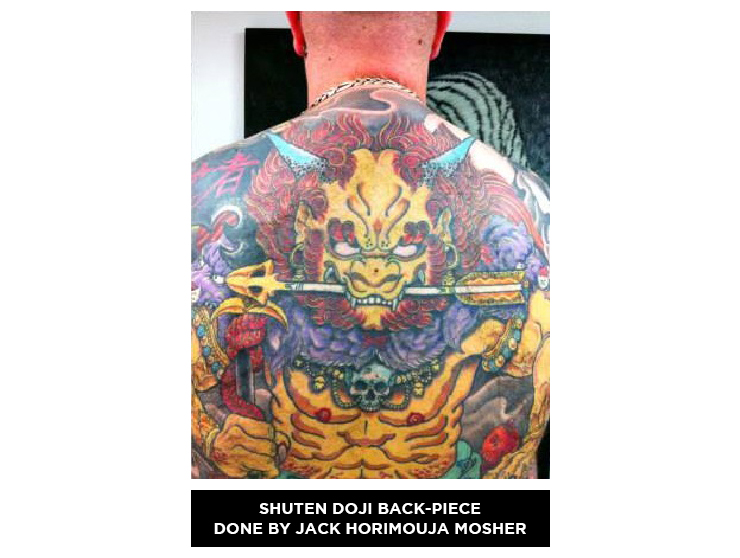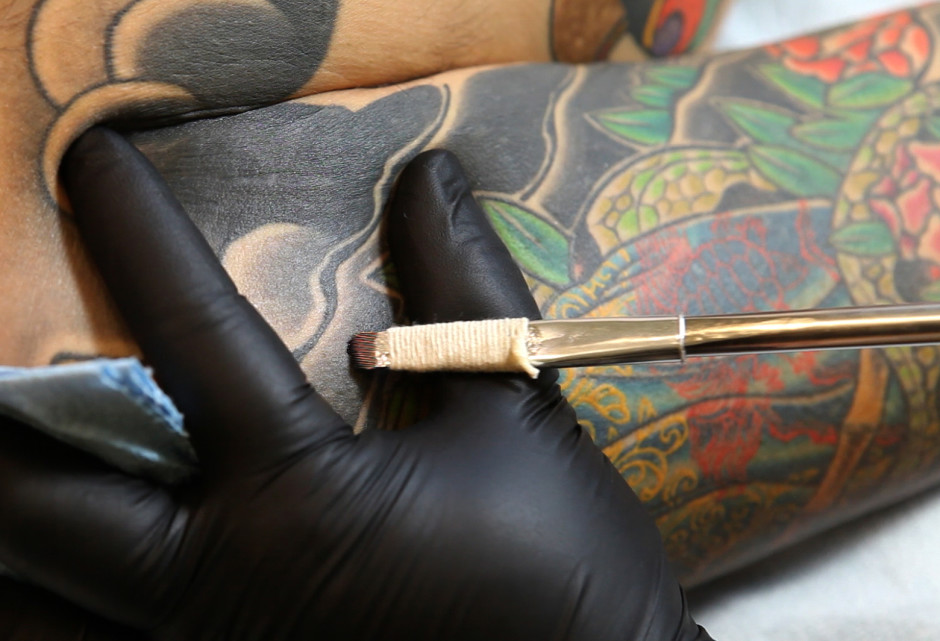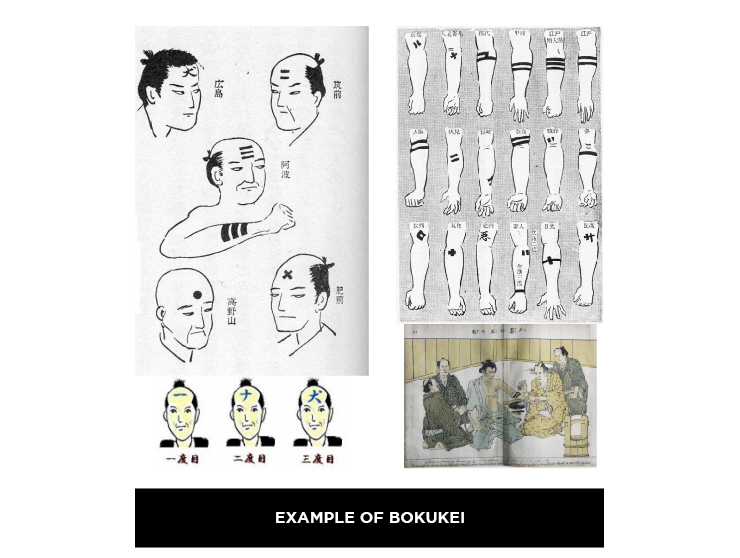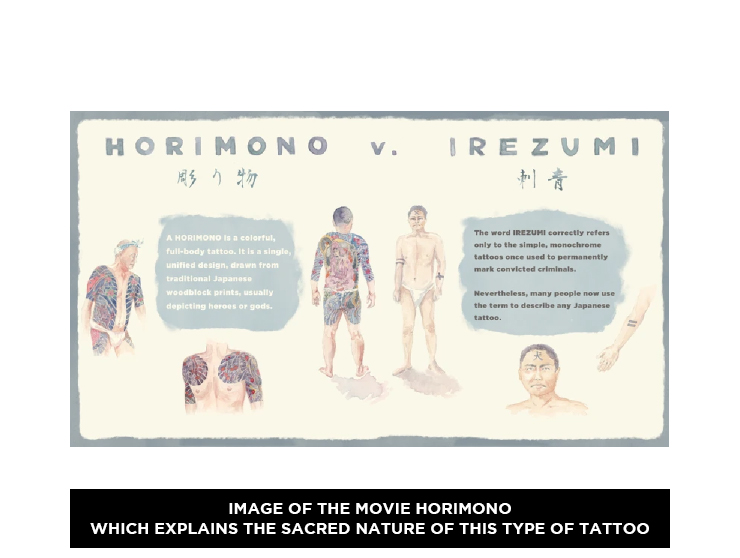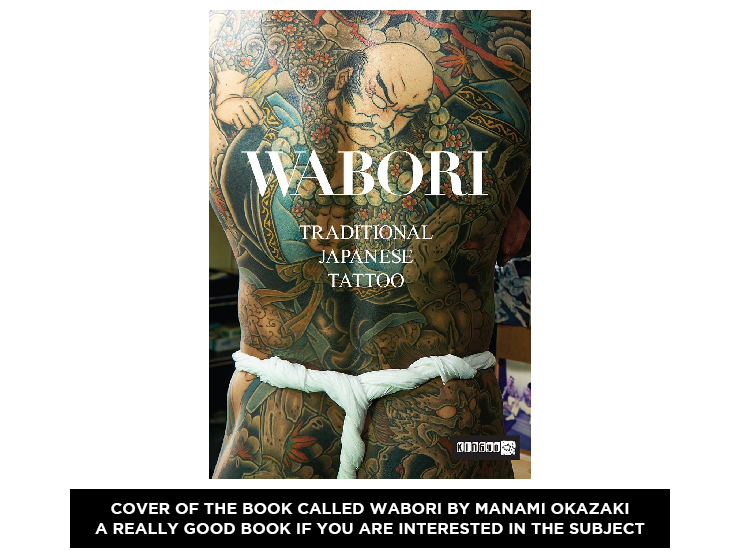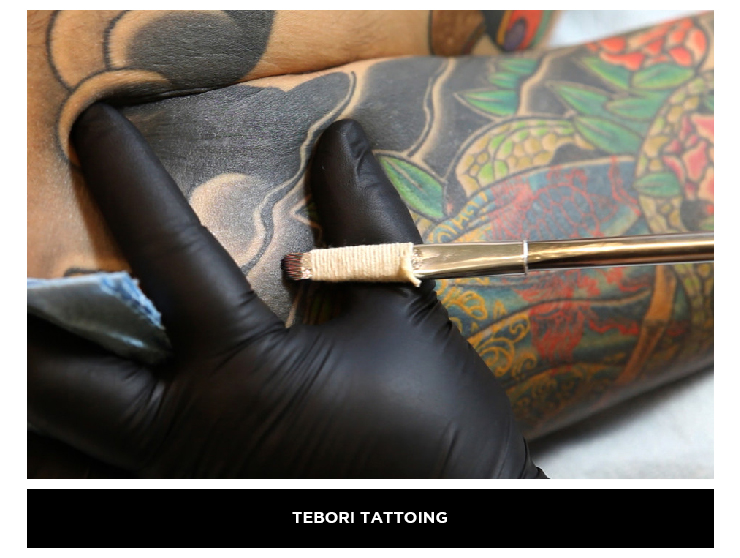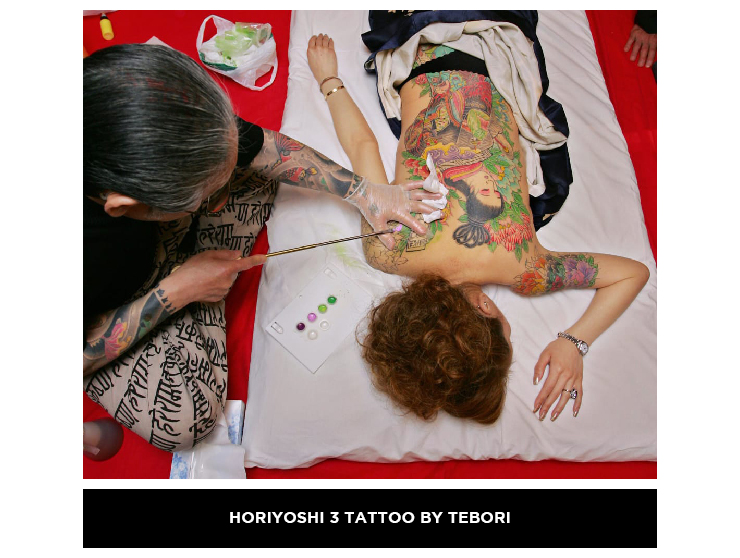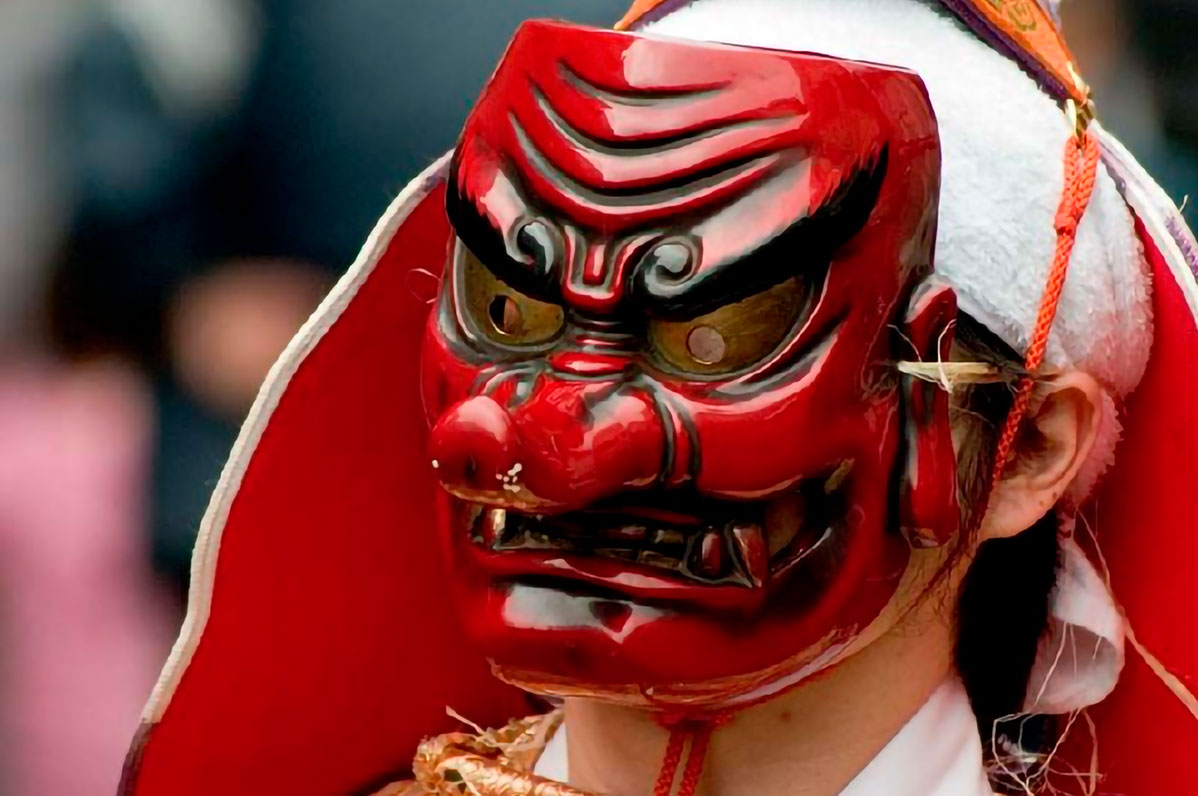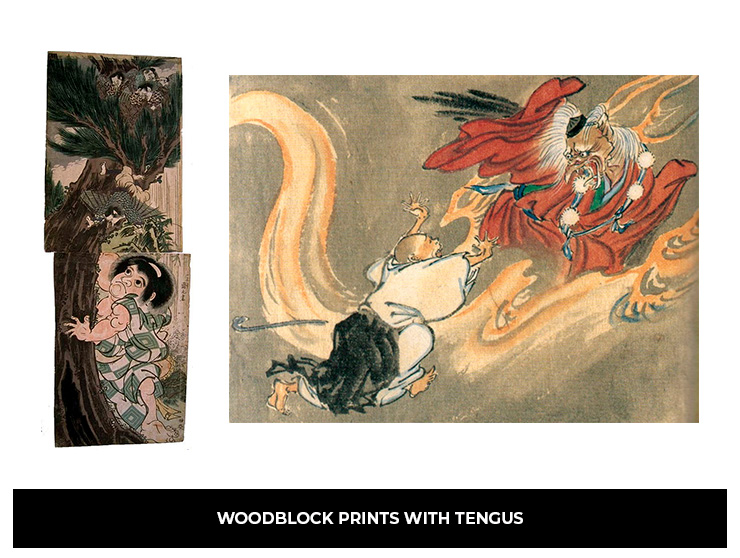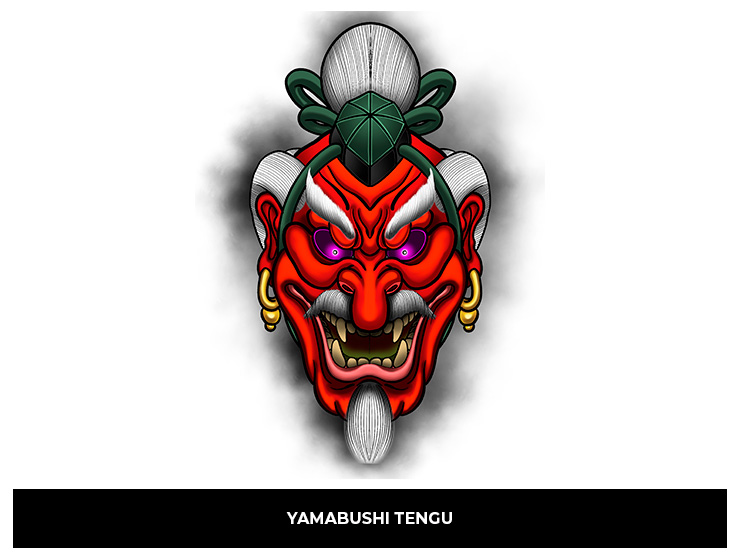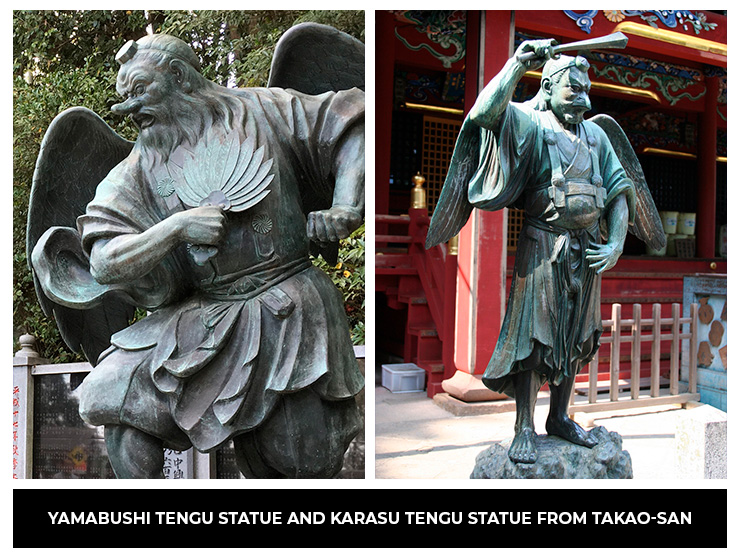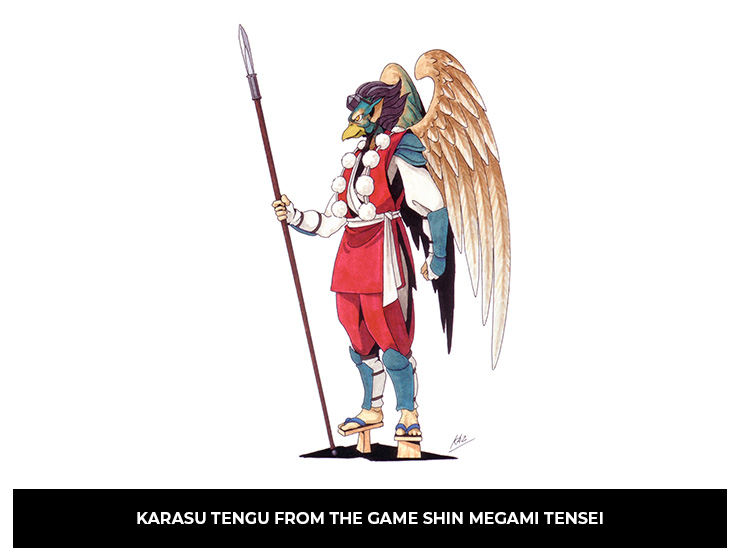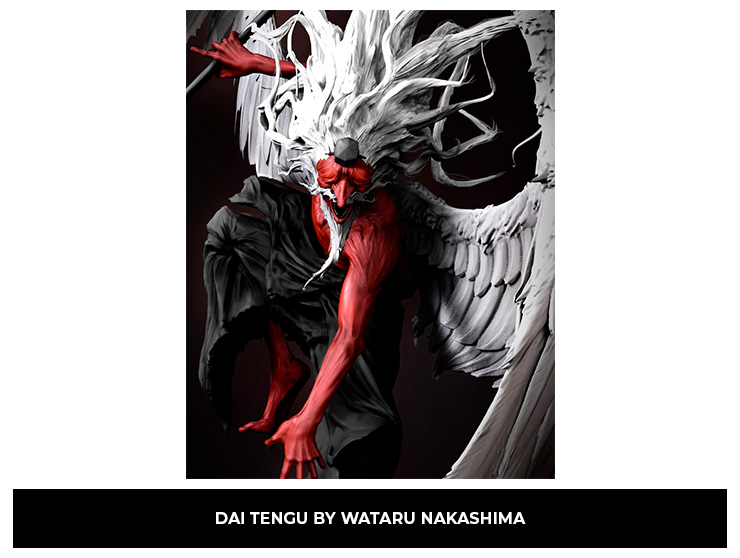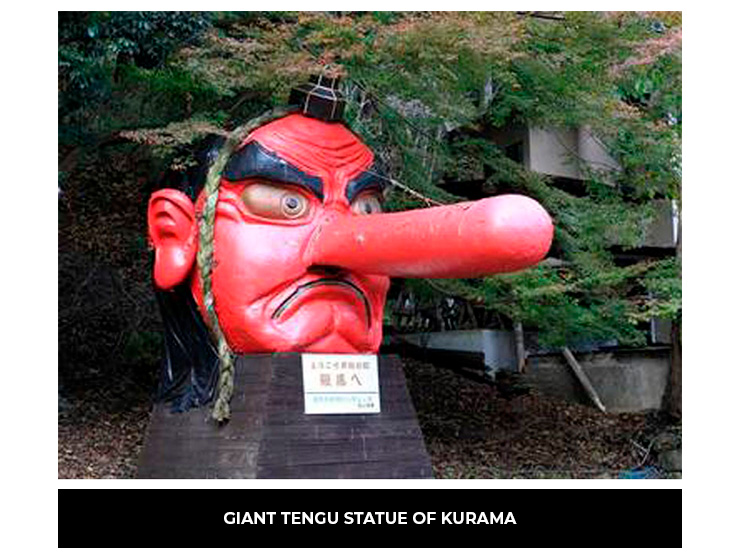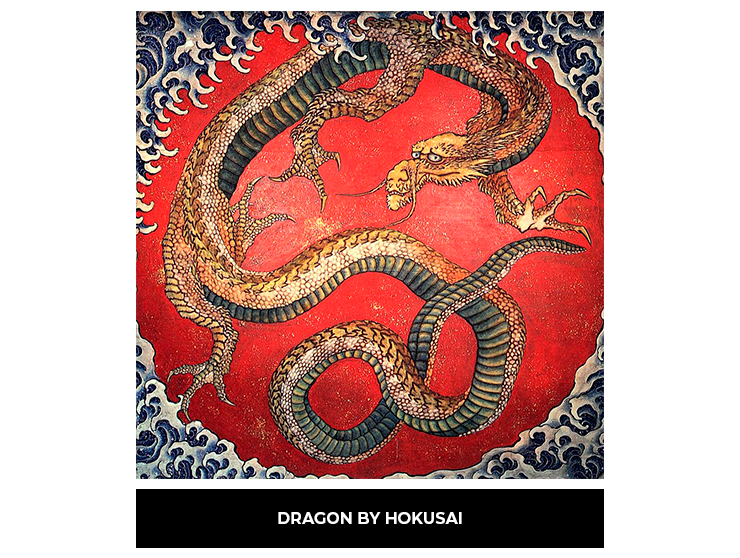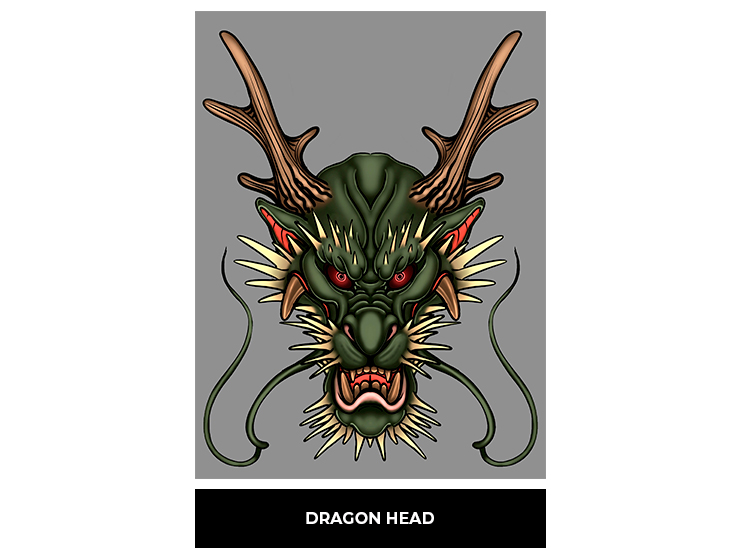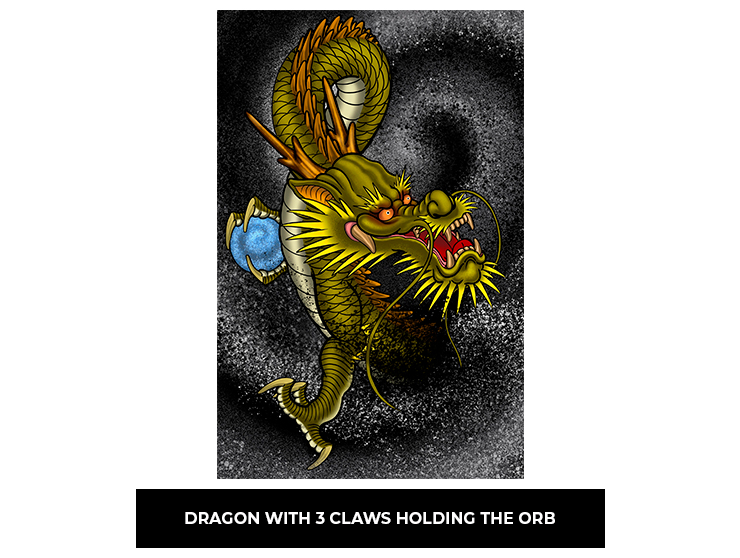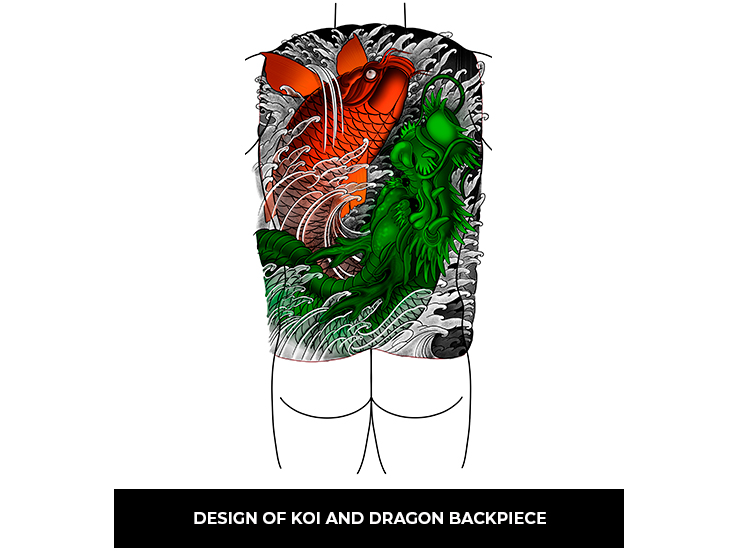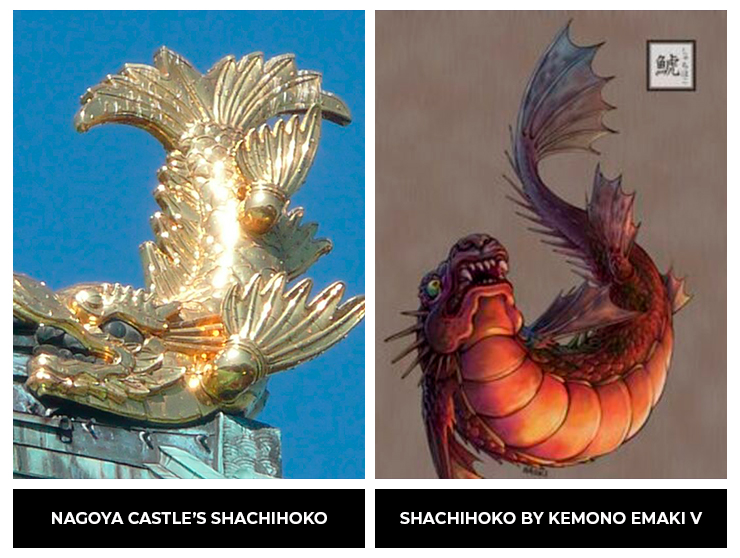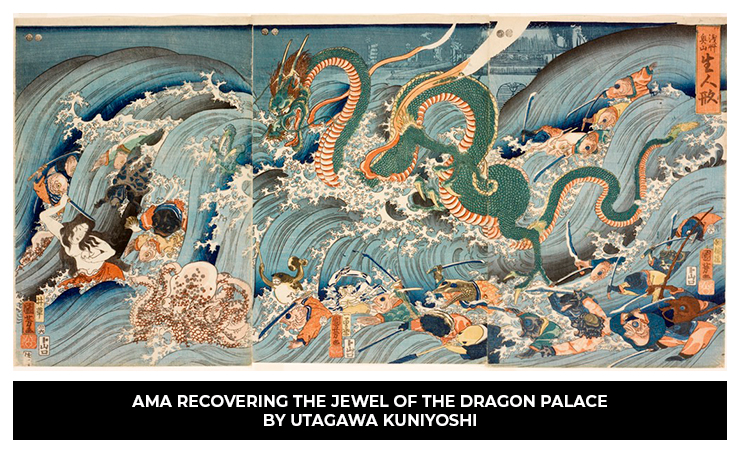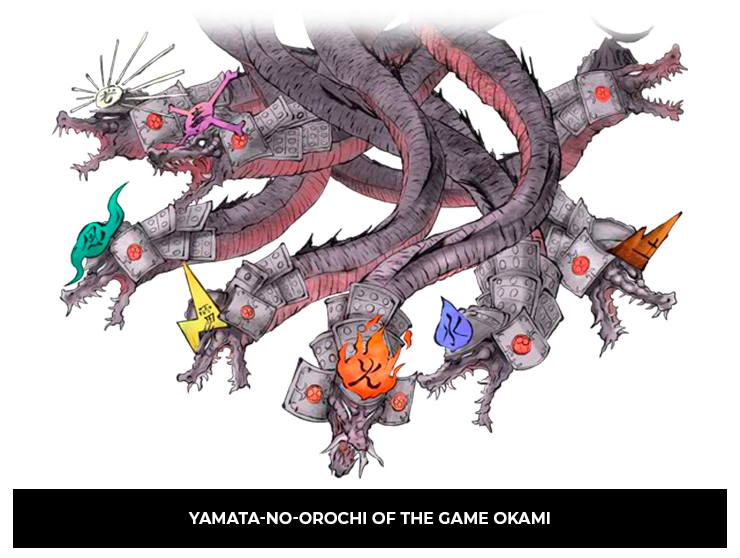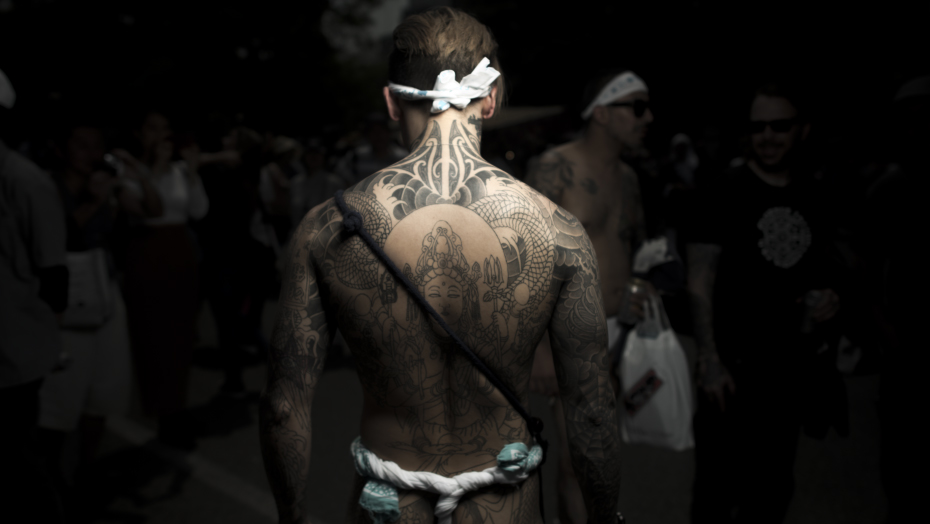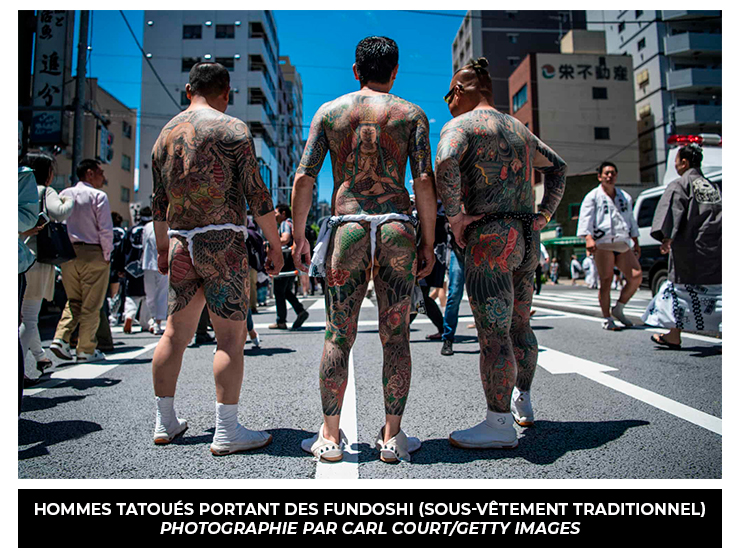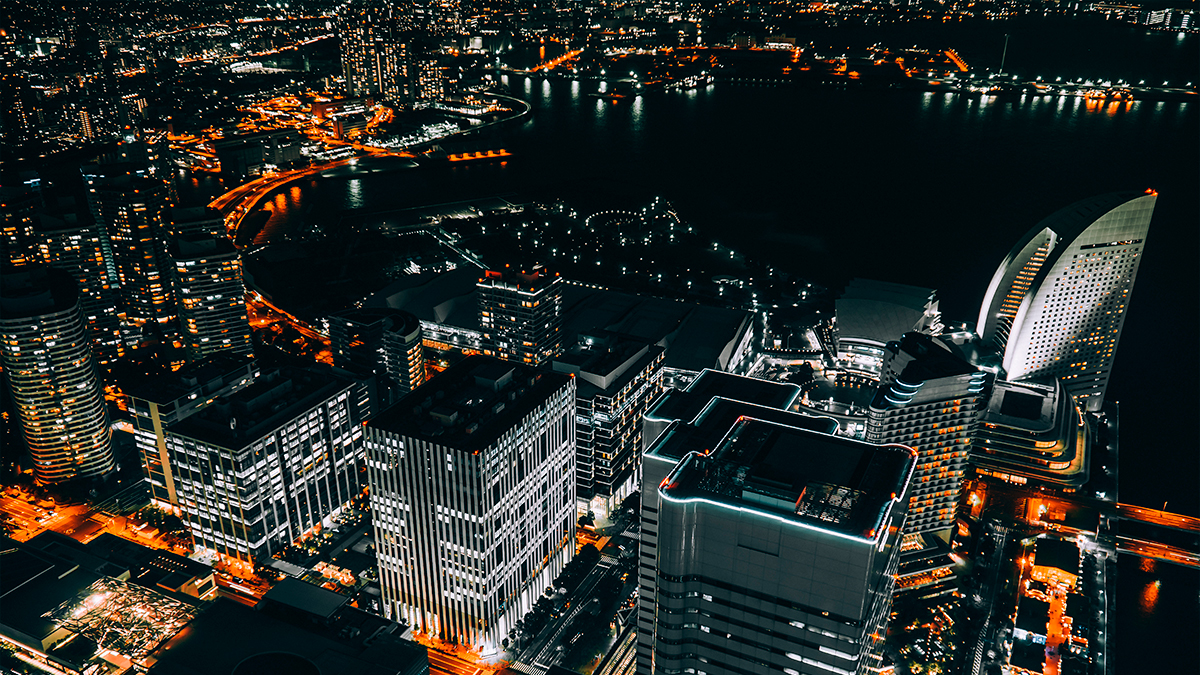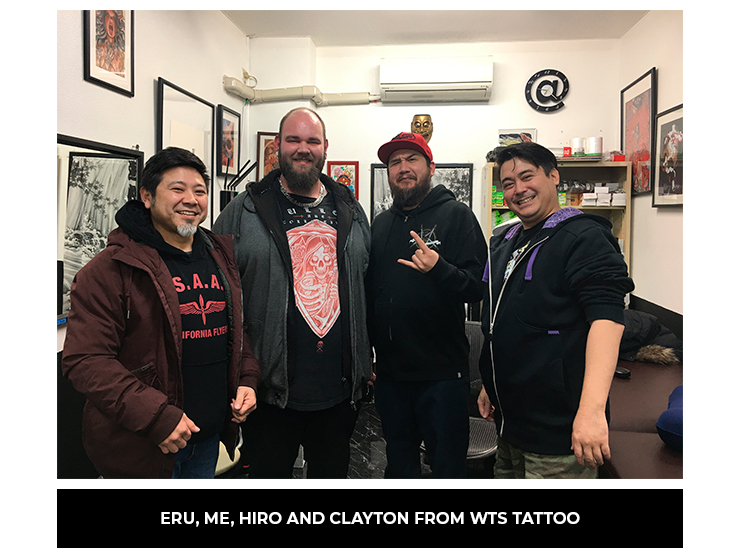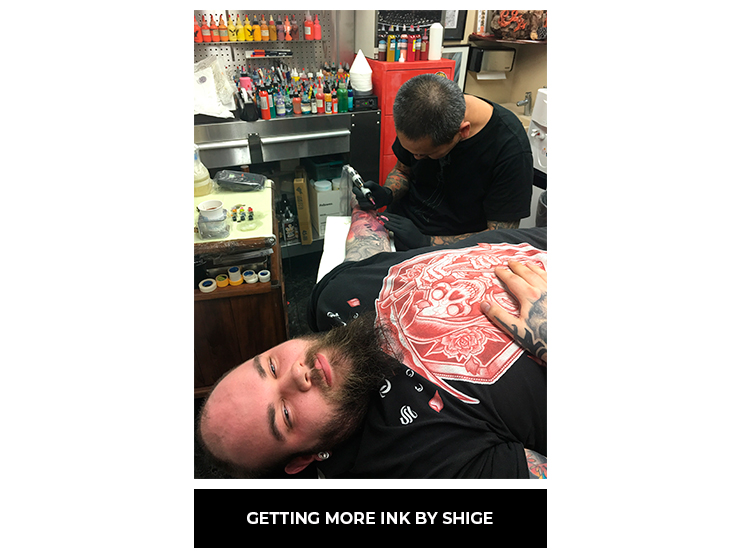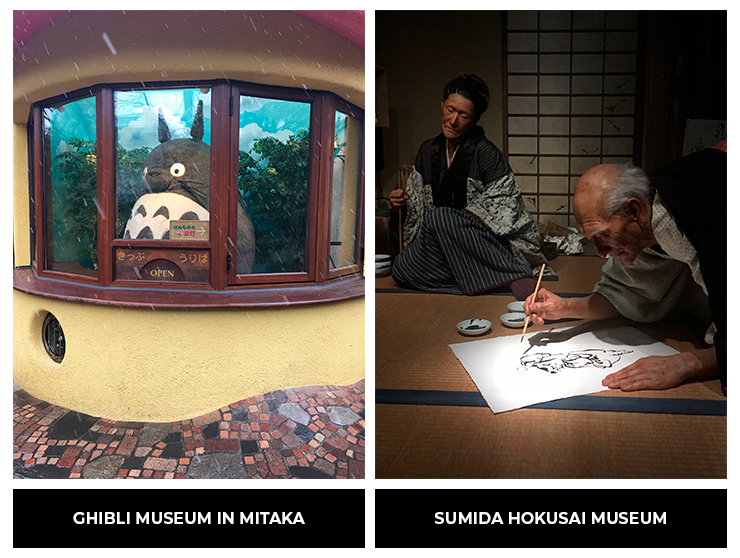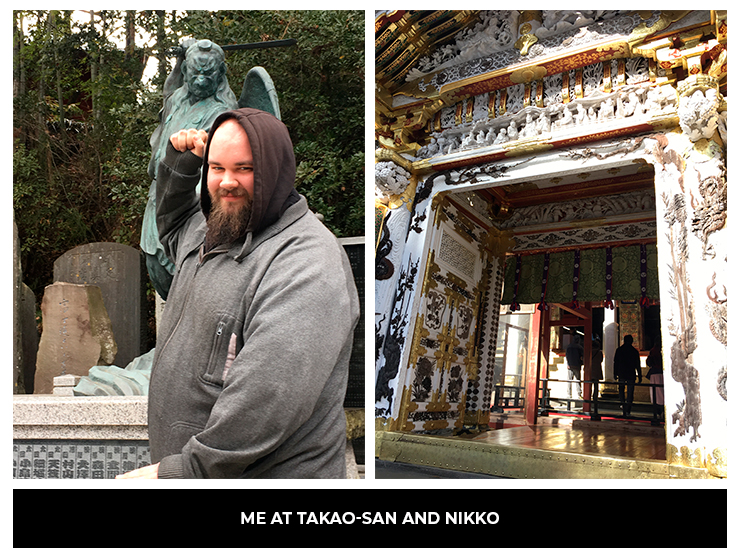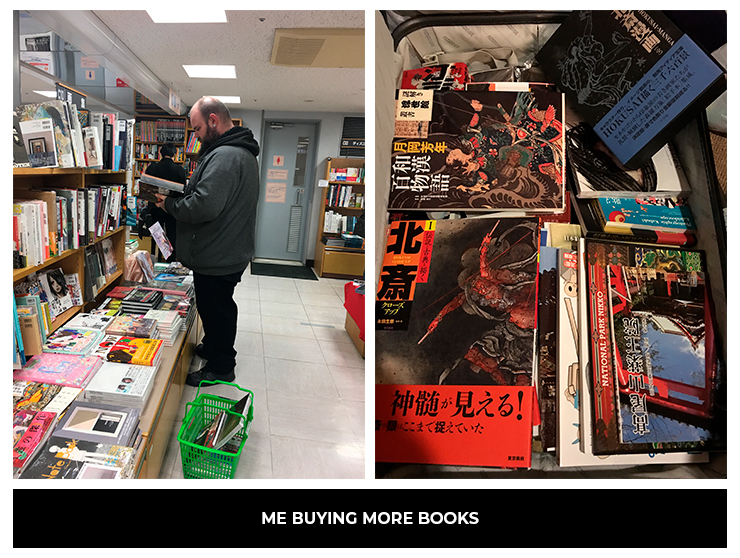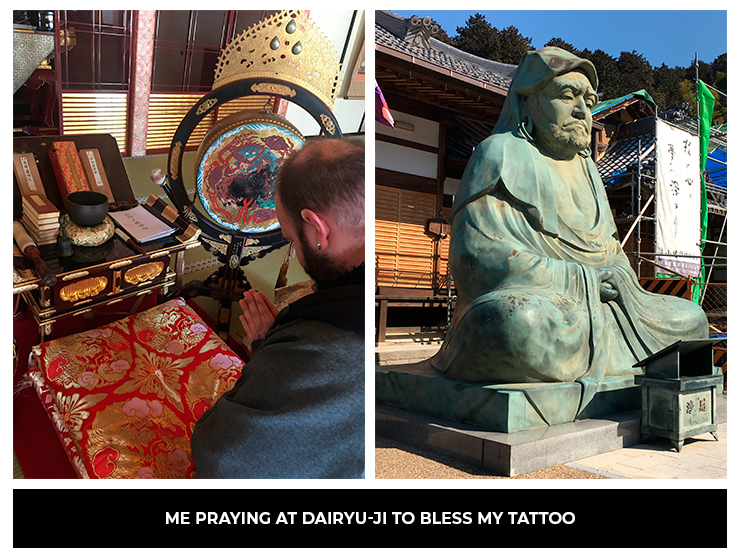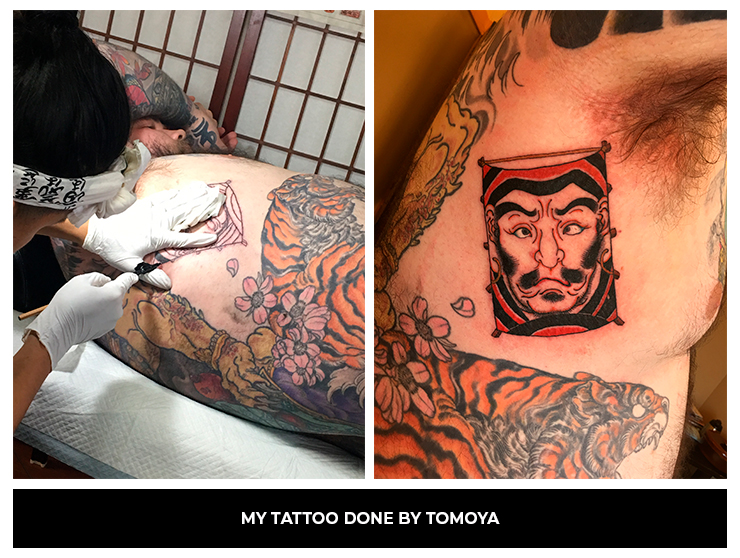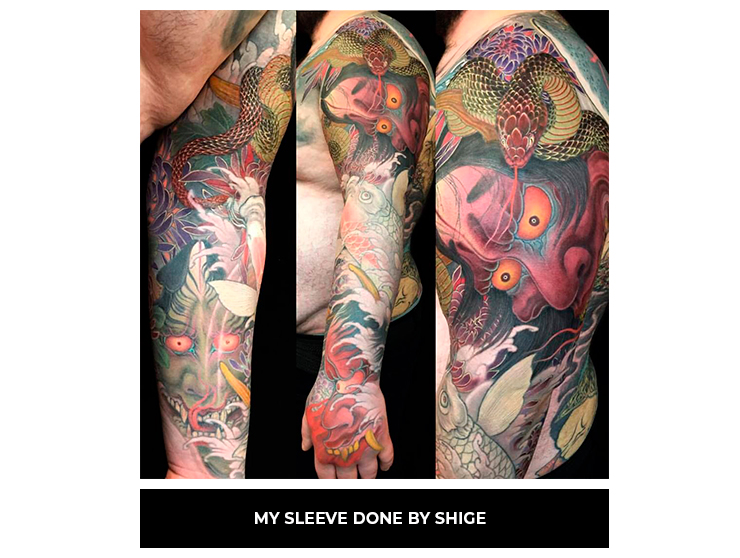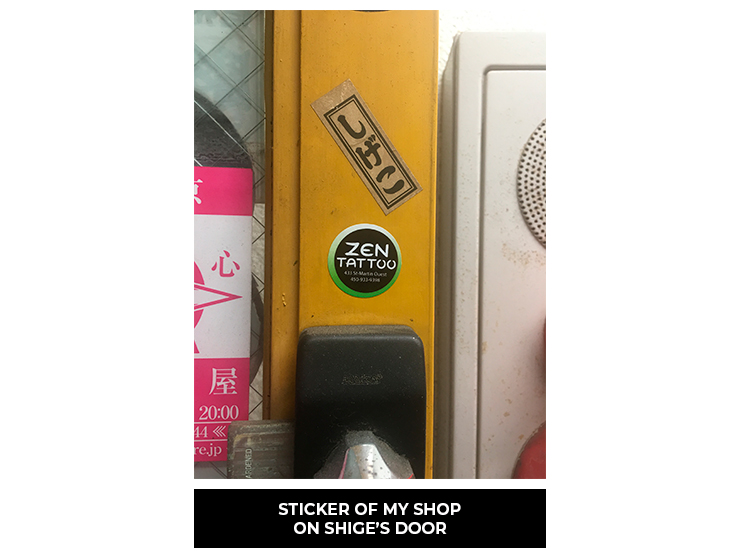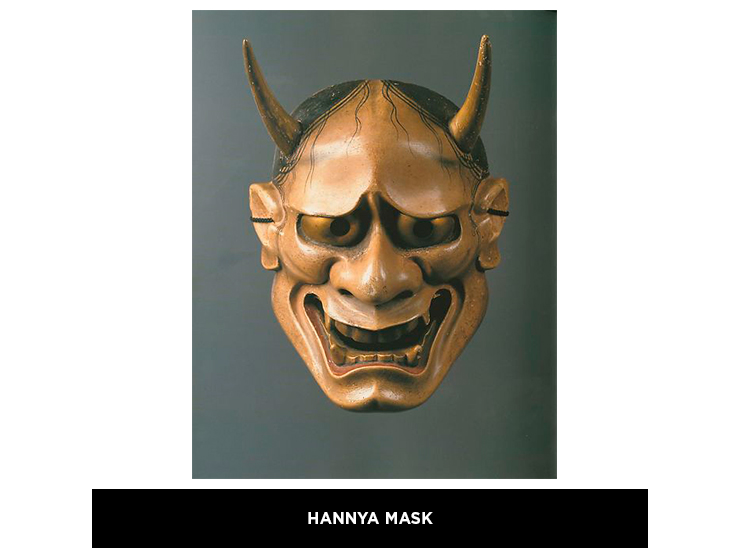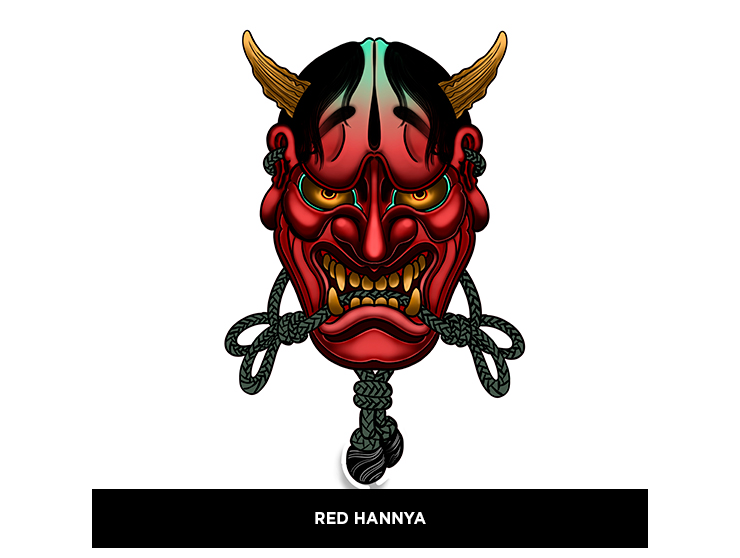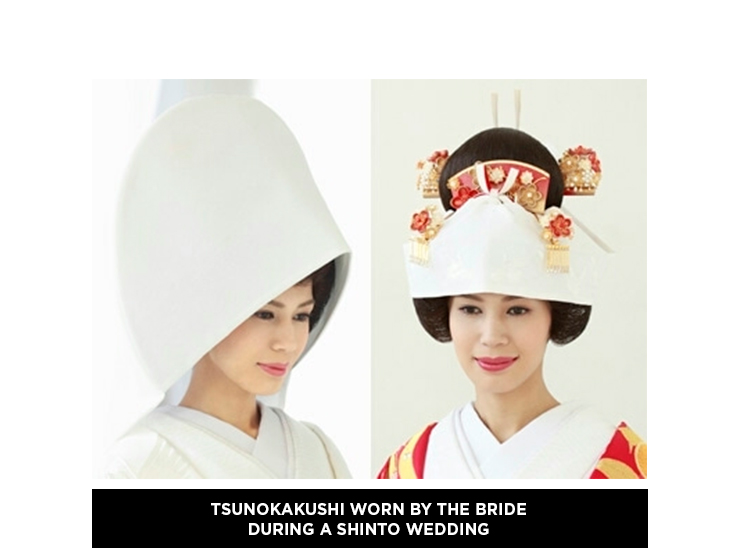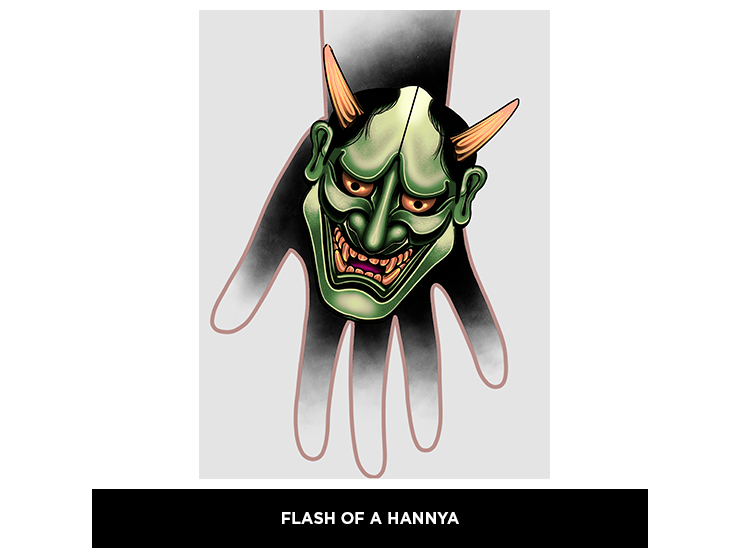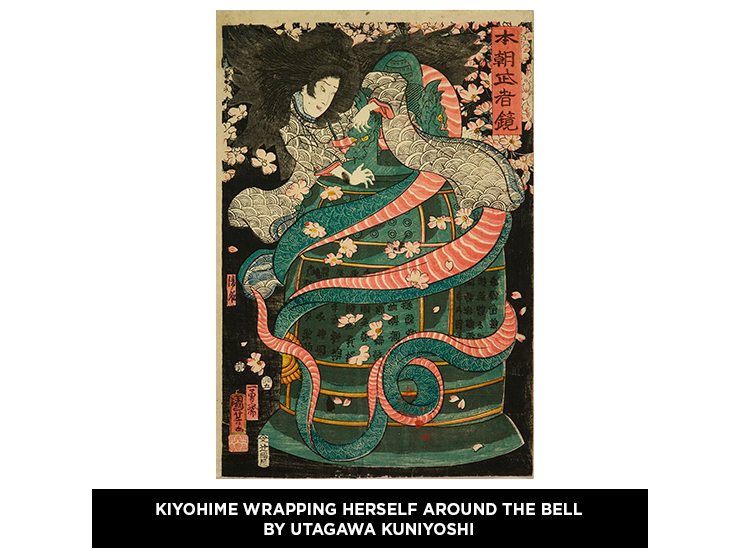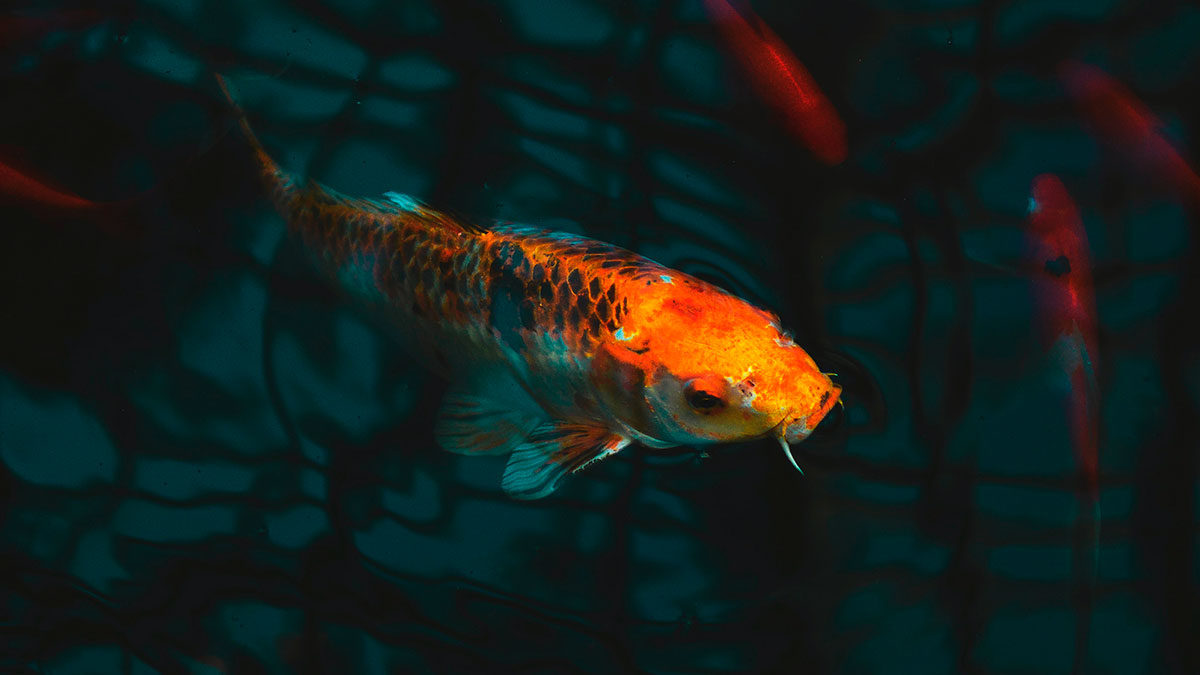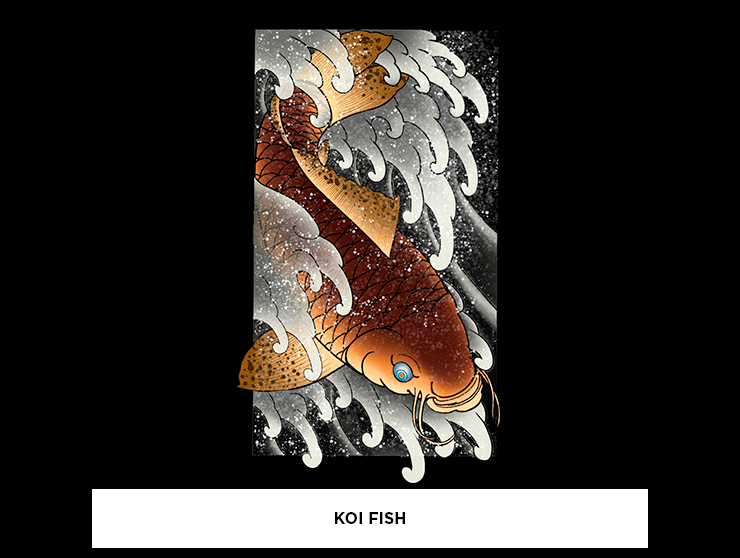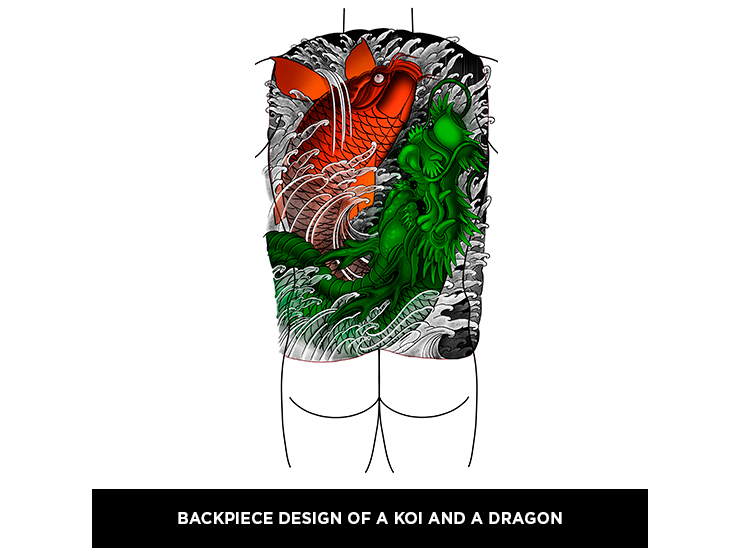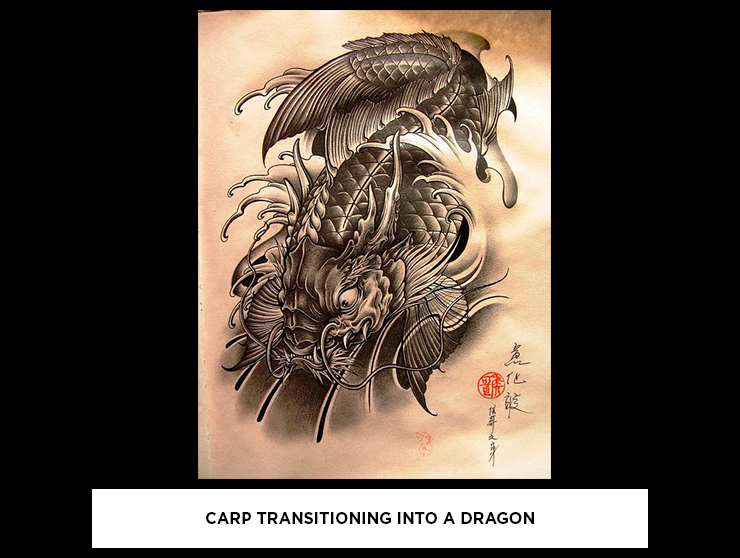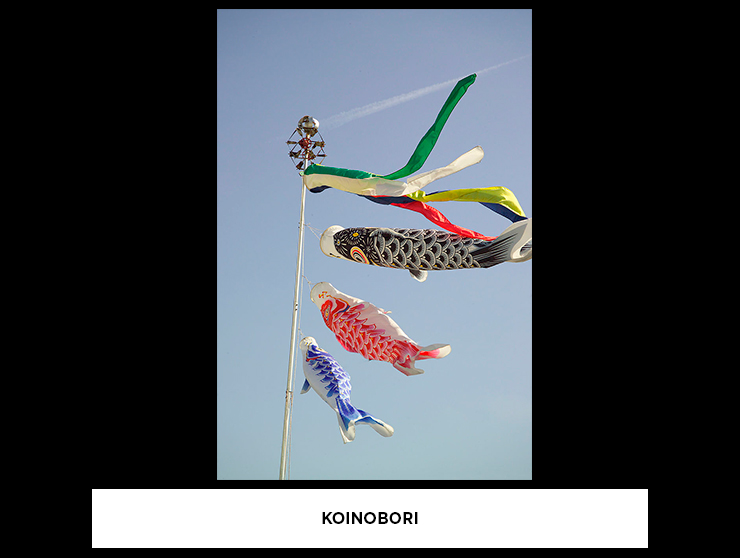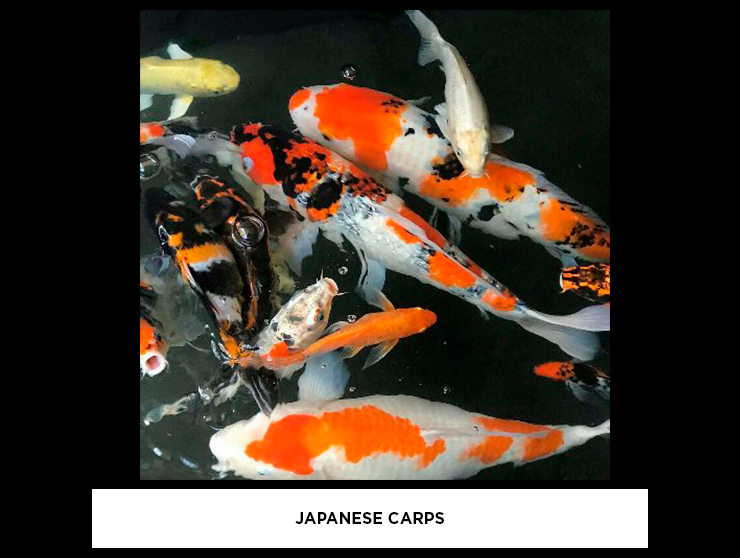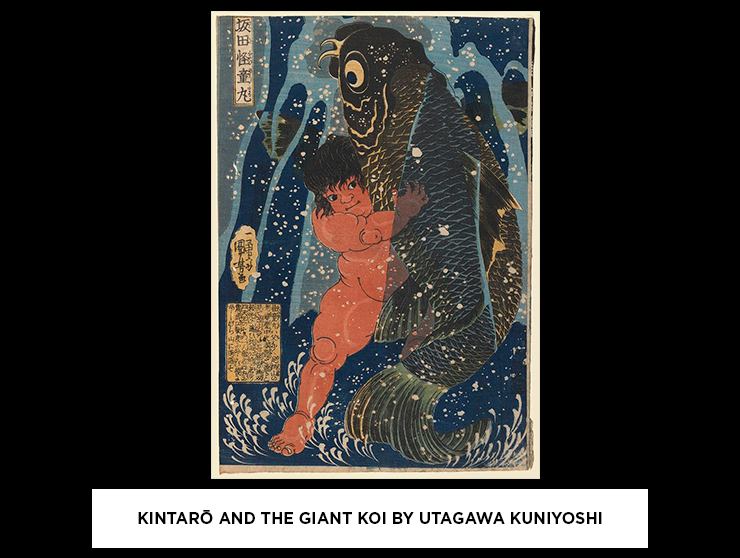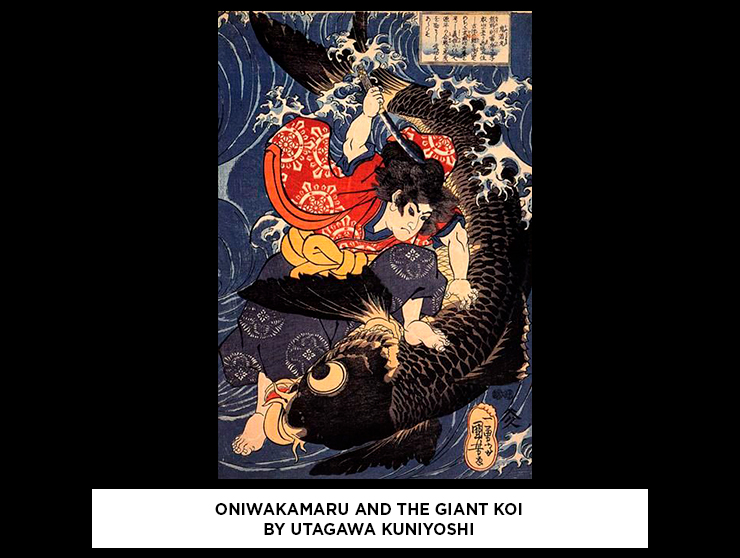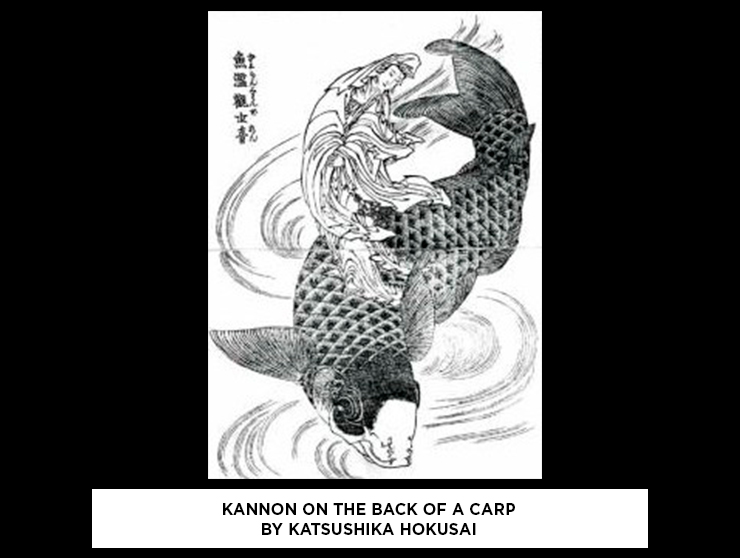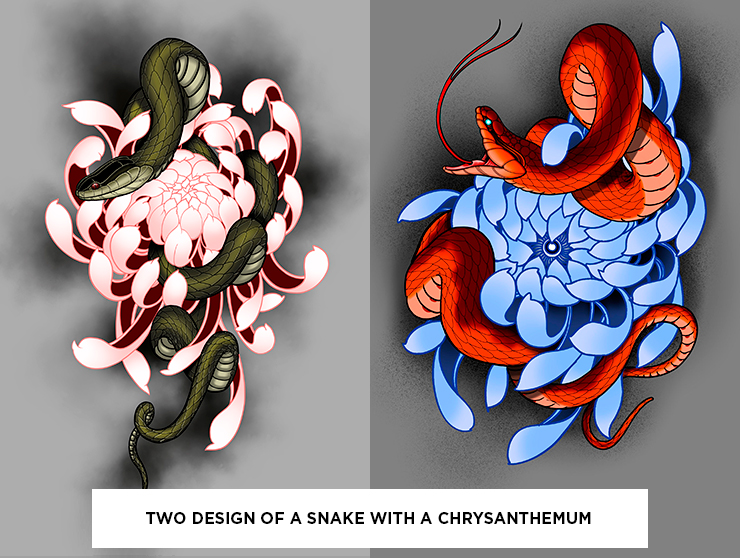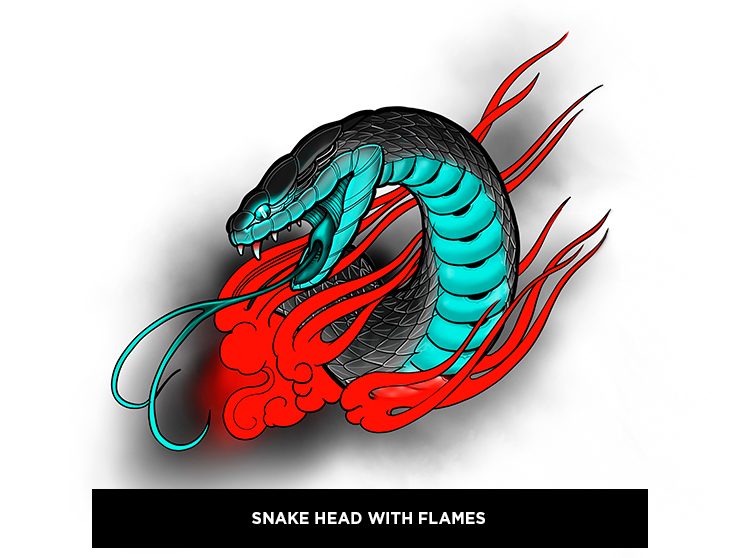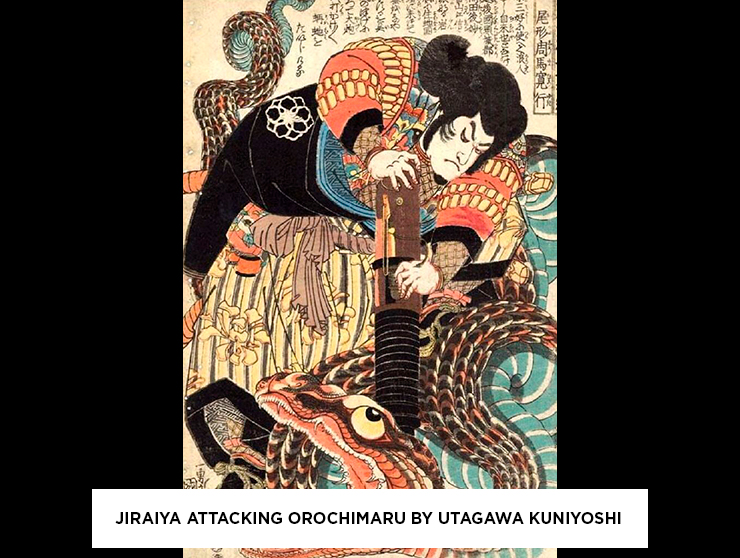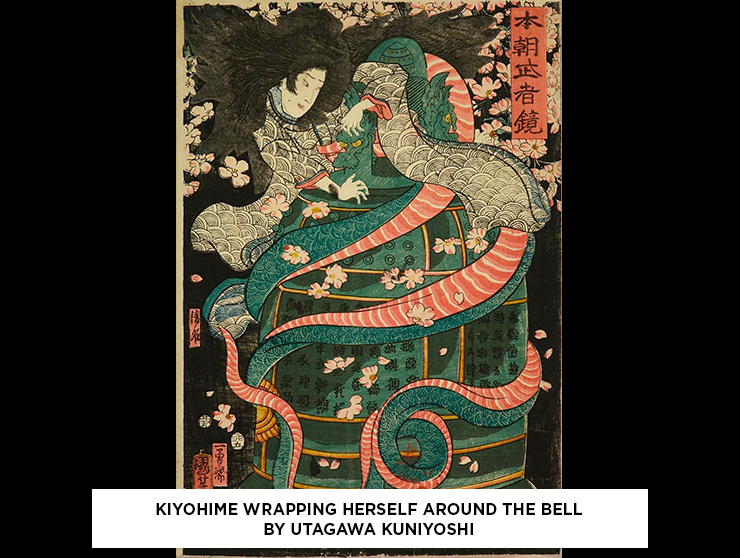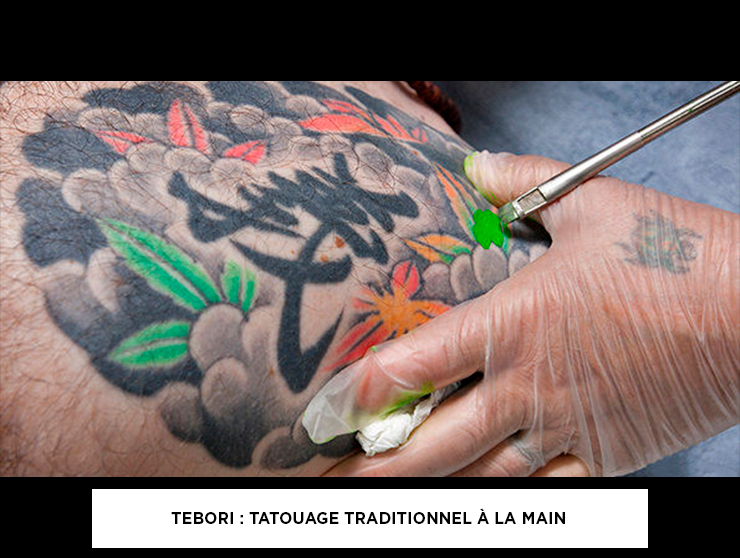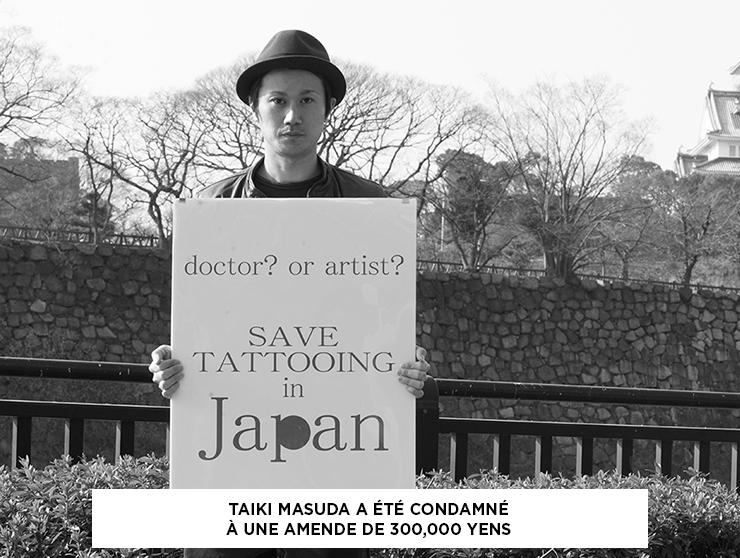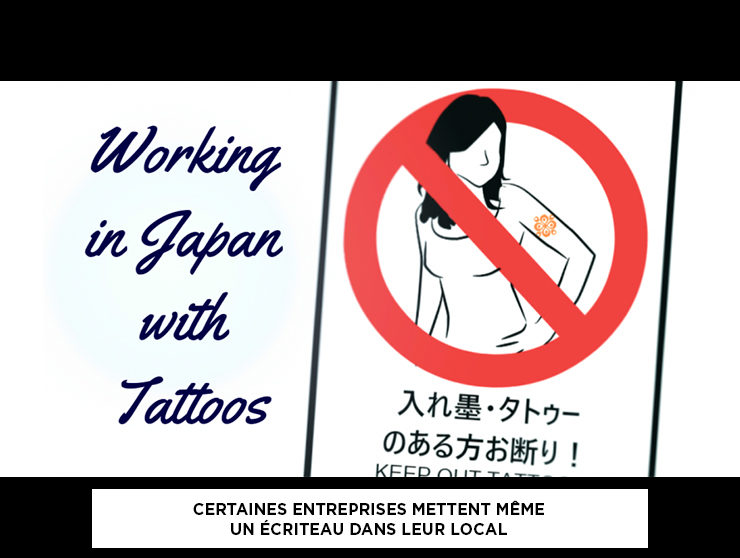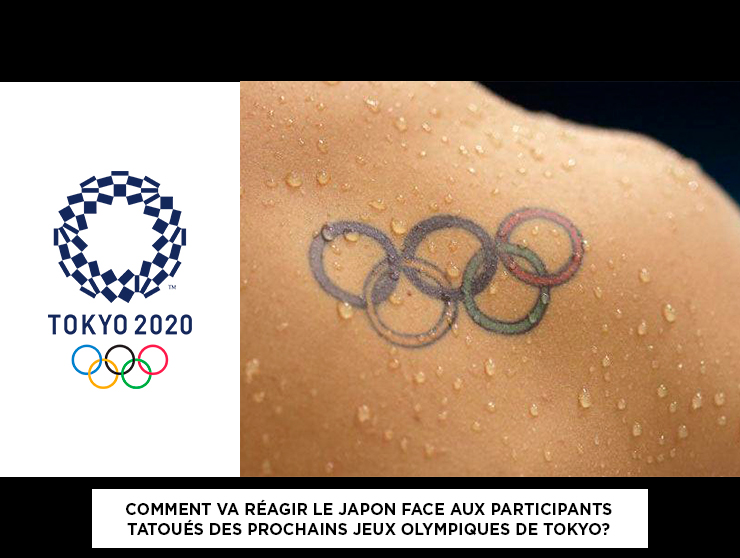Jack (Horimouja) Mosher – My back-piece done in 2 months
Jack (Horimouja) Mosher – My back-piece done in 2 months
The first time I visited a tattoo convention was the Art Tattoo Show of Montreal in 2007. I was fascinated; I passed hours looking at everything and I spent all the money I had to buy 2 books by Horimouja:
- 100 Japanese Tattoo Designs part II
- Bloody Japanese Prints
These books cost me 300$ which was a lot for someone working part-time at the minimum wage as a wrapper in a supermarket. I spent days studying and observing every drawing, every line. I decided there and then that one day I was going to get tattooed by Jack Mosher.
Fast-forward to 2009; I made an appointment to get tattooed at Body Armor Tattoo, his studio in Kalamazoo (MI). It was a 12-hour drive to get there. I went with my girlfriend, Virginie and my childhood friend, Patrick. A great road trip to get tattooed by one of my idols! I was exited and nervous.
I wanted a tiger on my ribs with a little rabbit at the bottom. When I arrived to my appointment, I was surprised to see that he didn’t prepare a drawing. He explained to me that he always did his design free hand. He then took a sharpie and started to draw directly on my skin. I was fascinated to see him working without a stencil! I knew his talent for drawing, so I wasn’t stressed at all about the result, I trusted his skills. I got tattooed 2 days straight and the result was better than what I had expected.
I really appreciated my time spent in Michigan. Watching Jack work and talking with him made me realize how much I could learn from him. I decided to let him do my back-piece, the biggest canvas on the body.
By chance Jack told me he was moving to Erie in Pennsylvania which was great because that meant he was living closer to me (8-hour drive instead of 12)! We scheduled a meeting to start the back-piece. I was hesitant between getting a back-piece of Taira no Tomomori, the valorous samurai, or Shuten Doji, king of the demons. I let Jack choose and he decided to go with Shuten Doji because it’s a less common subject.
Thanks to Shuko, Jack’s Japanese wife, he managed to incorporate multiple elements of the classic story of Shuten Doji. On top of that, my back-piece has a lot of hidden symbols:
- In the axe, we can read the kanjis 亡者, which are pronounced ‘’Mouja’’. Like in Jack Hori-mouja, which actually means dead alive or zombie. I now have his signature in my tattoo.
- He is wearing tiger skins on his shoulder, which references the traditional Japanese-time system. Shuten Doji would come out at the hour of the tiger (between 3:00 AM and 5:00 AM) to go hunting for his preys.
- Some jewelry has a fleur-de-lys design, which references my Quebec origins.
We had 3 months to finish my back-piece since Jack was moving to California because he had been offered a job at High Voltage (Kat Von D’s tattoo parlor). Therefore, with a lot of motivation, of sweat, and blood, we managed to finish my back-piece in 2 months in a half, even though there was an 8-hour drive between Jack and I.
Each week, I would leave Sunday at 6:00 PM after my shift in a tattoo parlor to drive to Erie, PA. I would get tattooed on Monday, Tuesday and Wednesday. I would leave Wednesday night and make it back Thursday in time for my shift. More than 60 hours of tattooing has gone inside this tattoo in just a couple of weeks.
For those wondering why I didn’t take a commercial flight to go and see him, I simply didn’t have the money for plane tickets. I preferred putting my money in my tattoo and my learning than in a comfy plane seat.
On top of getting tattooed, I spend a lot of time drawing and talking with Jack. He has one of the largest book collections I have ever seen! I spent hours looking at his books, he even gave me a book! We would spend nights drawing; he would explain different art concepts and show me different techniques. All those hours spent with him are worth so much and I’m truly grateful to have had such an opportunity.
Tebori tattoo 手彫り – Hand Carved Tattoo
Tebori tattoo 手彫り – Hand Carved Tattoo
It is impossible to fully understand Japanese tattoos if one doesn’t understand the Japanese words associated with this practice.
A common misconception is that all tattoos are frowned upon in Japan. This is true only for Japanese people wearing tattoos, they mostly do not really care about outsiders having tattoos. This tattoo snobbism dates a while back, during the Edo period (1600-1868). During those times, tattoos were used to mark criminals of their petty crimes (ex: stealing). Petty crimes would not require a death sentence, but the authorities would mark the criminal with a visible tattoo to warn the population. This type of punishment was called Bokukei. After time, groups of criminals (like the Yakuzas) would seek out tattoo artists to get their bokukei covered by elaborate and beautiful tattoos.
These tattoos were done on criminals to warn the population of their mischief. This punishment was done for petty crimes since the death penalty was very present in ancient times in Japan.
Tattoo artists, called Horishi, started to make complex tattoos with colors and designs. Based on Japanese woodblock prints, they would create a piece of art on the skin of their client. This is where a second word for tattoo came to be: Horimono (which means tattoo).
Today, the word that is most used to design tattoos is Irezumi, which is a general term for tattoo. Irezumi is mostly used to design simple tattoos as Horimono is used to design large and elaborate tattoos.
Here is the link for the movie: https://www.youtube.com/watch?v=q1h8K92cEag
Different reasons explain these different ways of saying the word “TATTOO” in the Japanese language. The main reason is that during the Meiji era (1868-1912), the government made a law stating that tattoos were illegal. This resulted in the criminalisation of the art. Therefore, all the words associated with tattoos (like bokukei, horimono and irezumi) were associated with criminal activities. Event if it has been more than a hundred years, you can still feel the unease of Japanese people when they say these words.
On top of all those different words to say tattoo, there are two different styles of tattoo in Japan. Yobori is used to describe Occidental tattoo done at the machine, while Wabori is used to describe traditional Japanese tattoo done by hand (by Tebori).
Yobori is traditional tattooing like we know it. Done with an electric tattoo machine, this type of tattoo was imported to Japan by Americans. Yobori refers to the classic tattoo styles such as Old School, New School, Neotraditional, etc. everything that refers to the occident.
Wabori was invented in Japan and is what we call Japanese style. Based on woodblock prints and classic Buddhism imageries, wabori regroups everything that is Japanese in a tattoo. Wabori is tarditionnally done by Tebori (by hand).
Before electricity, Tebori was invented during the Edo period by Horishi to cover-up bokukei (punishment tattoos) with elaborate horimonos. Tebori is done by putting needles at the end of a bamboo stick. The ink is inserted in the skin by a thrusting motion done by hand by the Horishi.
Both tattoo styles are practiced in Japan. Some artists simply practice wabori while certain can do both wabori and yobori. This mainly depends on the master and the tattoo family.
Having fewer artists doing tebori tattoos, there are certain myths around this mysterious practice. Some believe that a tattoo done by tebori is magical and protects the wearer because the artist puts his entire self in the tattoo, like a talisman. In Japan, a tattoo done by tebori has a bigger spiritual value than a tattoo done by a tattoo machine.
There seems to be two characteristics that are true surrounding tebori:
- Tebori tattoo is less painful than tattoos done by machine since there are less needles perforating the skin by second.
- Colors tend to stay flashier longer since more pigment is inserted under the skin.
But keep in mind that not every type of tattoo can be done by Tebori. Usually, the tattoo style associated with tebori is Traditional Japanese tattoo because this style has a lot of flashy colors, not a lot of shades and bold lines. It would be impossible to do a portrait by Tebori.
Yes I do tebori !
I do tebori tattoos, but I choose pieces that I know will be better done by tebori than by the tattoo machine. I don’t do everything by tebori.
It’s important to understand also that a tattoo done by Tebori takes more time and is therefore more expensive. For more information or to ask for a Tebori tattoo, you can fill up my online form: www.jftattoo.com
Tengu – 天狗
Tengu – 天狗
Tengus are cunning mountain dwellers. Their origins can be traced back to ancient China where they were referred to as “Heavenly Dogs”. They protect the mountain where they live and are even considered to be the mountain’s kami (Shinto god). They despise vain and narcissistic people. In the mountain you will be trialed: If you are a good person, the Tengus will reward you. But if you’re disrespectful, you will be punished!
Tengus are known for their great skills in martial arts. They train intensively in the mountain, like Shaolin monks. In combat, they are as good or even better than any men. Only a rare few Japanese warriors have had the chance of training with them. Some stories say that after years of training, master Tengus can achieve teleportation and telepathy.
Tengus also enjoys playing tricks on wanderers lost in the forest. They can fly and transform at will. They are little rascals; their straw coat can make them invisible. They make themselves visible only to those they judge worthy of their presence. During my third trip to Japan, I had the chance to climb Takao-San, which is known as the Tengu mountain. Unfortunately, I did not encounter a Tengu. 😉
There are 2 types of Tengus: the Karasu Tengus and the Yamabushi Tengus.
- The Karasu Tengu are the crow-faced Tengus. They are the most aggressive Tengus and are master swordsmen. Descendants of the God of Storms (Susanoo), they can destroy everything in their path.
- The Yamabushi Tengu are the long-nose and red-skin Tengus. They are more docile and have more human like features. They are much stronger and wiser than the Karasu Tengus. They like to show how great they are by using their slyness to get out of conflict. One Japanese expression actually reflect this: « Tengu ni naru » which means to become a Tengu, refers to someone who is showing off.
The Dai Tengu is the chief of all Tengus. He resembles a Yamabushi Tengu but is even more humanesque in appearance. He is the wise sage on top of the mountain. He is the strongest and smartest of all the Tengus.
Tengu story
Kobu-tori Jiisan (瘤取り爺さん)
An old man had a lump on his face. One day while walking through the mountains, he meets a group of festive Tengus. He decided to join them and dances with them. The Tengus where so impressed with his dancing that they asked for him to come back the following night. To make sure he came, they give him a gift and they also magically removed his lump. They decided to keep the lump, thinking that he would return the following night to take it back. His evil neighbor, who also had a lump, hear the amazing tale and decides to go see the Tengus the following night. But the neighbor, not only doesn’t dance well, he tries to steel the Tengu’s gift. Disgusted by him, the Tengus give him a gift to remember: the lump of his neighbor. Now he has 2 lumps instead of one.
Japanese Dragon – 龍 (Ryū) or 竜 (Tatsu)
Japanese Dragon – 龍 (Ryū) or 竜 (Tatsu)
The dragon is by far the most famous mythological animal. Its appearance varies from a region to another and it also varies in time. For example, everyone is familiar with the medieval dragon that looks more like a lizard, while the Chinese dragon looks more like a snake.
In Japan, the dragon is considered to be a mythological creature, meaning that it’s not a monster and it’s not someone who has been hexed/cursed. It’s a rare animal! A dragon with one head is considered benevolent, while a dragon with multiple heads is considered evil.
Appearance
In old Japanese textbooks, the dragon is translated to “Snake or Naga”. This is because they are all considered to be the same animal: an aquatic serpent.
Traditionally, the dragon has the wingless body of a snake, the head of a camel, the antlers of a deer, the eyes of a hare, the ears of a bull, the scales of a koi, the paws of a tiger, the claws of an eagles and whiskers.
Still, the dragon is a mythological creature, therefore its appearance varies accordingly to the artist’s will. There is one important particularity: the Chinese dragon has 4 to 5 claws while the Japanese dragon always has 3 claws.
The dragon can be seen in tattoos paired with the tiger. The dragon reigns in the sky, while the tiger dominates the land. Together, they are two very strong creatures that represent the balance of power. The dragon can also be paired with a phoenix, which would represent union in love or in rivalry. Like in the Yin Yang symbol, the emperor would wear the emblem of the dragon (masculine), while the empress would wear the emblem of the phoenix (feminine).
Symbolism
The symbol of the dragon (and of the snake) is one of wisdom and protection. Associated with water, Edo period firefighters were the firsts to get dragon tattoos as a talisman against fire. Dragons are also known for their strength, intelligence and compassion.
Usually they are tattooed with a background of clouds which symbolizes immortality and eternal youth. They can be seen holding a round jewel: this pearl lets the dragon travel through realms. The orb is also said to contain the spiritual essence of the universe and symbolises wisdom and luck.
As mentioned, the dragon is a mix of different animals. Thus, it is used to represent life with all its different milestones: The classic Chinese story of the dragon tells of a koi fish that decided to go upstream. While swimming he met different animals with unique characteristics. With each animal he met, he gained an attribute of that animal. For example: after meeting the hawk, it gained the hawk’s claws. After meeting the snake, it took the snake’s body. Until it finally reached the top of the river with all its new attributes and became a dragon. This story can be used to represent milestones or important people you meet in your life; each and every important person or event in your life changes you and turns you into a dragon.
There are also tattoos of transitioning dragons. An animal half fish and half dragon, like the famous shachihoko, is usually used in tattoo to express a journey that has begun, but that hasn’t ended yet. Statues of shachihoko can be found on roofs of temples and castles as a talisman against fires.
Famous dragon stories
Ryujin is the God of the sea. He is a majestic dragon that can control tides with a magical jewel and he lives in a beautiful palace at the bottom of the sea. There are multiple tales involving Ryujin.
Yamata-no-orochi is an evil, eight-headed dragon who would terrorize a village. Each year, he would devour a young girl. Susano-o, God of the storms, managed to kill him and found in his dead body the famous Kusanagi-noTsurugi, the Japanese version of the Excalibur.
The end of the Tattoo Ban
The end of the Tattoo Ban
I’m very happy to deliver some good news in this crazy year that is 2020: On September 17 th , the Supreme Court of Japan (which is the highest court in the country) has LEGALIZED TATTOOING IN JAPAN!
I do not want to get in the technical details about the judgement, but in short, it means that tattooist don’t need to possess a medical practitioner’s license to tattoo. As mentioned in my last blog about the « Tattoo Ban », tattooing had fallen in a gray area of the law: Technically speaking, tattooing was not illegal but you needed a medical license to practice the art.
Therefore, according to the law, tattooists (who of course didn’t possess a medical practitioner’s license) were tattooing illegally. Indeed, in 2015, the court of Osaka condemned Taiki Masuda, a tattooist of 30 years old, to a 300,000 yens fine (approx. 3,600$ CAD) for violating the medical practice act, which reserve the right to tattoo to doctors only.
After 3 years of going back and forth, Taiki Masuda won his process in 2018. Still, we had to wait until 2020 to have the Supreme Court of Japan out rule this crazy law.
It’s huge news in the tattoo world! For artists in Japan, it’s seen as a huge relief! This means they can finally come out of hiding. They can start renting commercial spaces to tattoo, put banners outside their shops and even import tattooing tools and goods without the risk of getting arrested.
The Tattoo Ban has been very hard on Japanese tattooists. Since the ban, a lot of tattoo parlours have closed and a lot of Japanese tattooists have moved to other countries to practice their art. It’s possible that some Japanese artists decide to return to their homeland because of this news.
It’s important to keep in mind that this news will still have a low impact for now. The hardest step is still to come: changing the mentality of Japanese people towards tattoos. It will take years maybe even decades to have tattoos accepted as something mainstream by the population.
Tattooed people and tattooists know that they will still be stigmatised because of their ink. Banks, schools and companies will still have a negative attitude towards them. Nevertheless, they are very happy to see the government take a step in the right direction.
Acceptance will take time, but I’m very happy for my fellow tattooist in Japan! They can now practice the art they love without fearing of being criminalized.
Third trip to Japan – February 2017
Third trip to Japan – February 2017
This being my third trip to Japan, I’m less stressed because I know my way around and I have made a couple of friends down the road. I started this trip by visiting Eru-san. He a tattoo machine builder and he is the owner of WTS Tattoo shop in Kanagawa. Eru-san took the time to show me his workshop and his shop. He asked me to come and do a guest spot next time.
After that, I had 2 days of tattooing to get done on my arm. Shige did the inside of my upper arm: ITAI! (痛い), meaning OUCH in Japanese! Once again, I took the time to appreciate being at Yellow Blaze studio and discuss with Shige.
Since I had 2 more sessions of tattooing to do with Shige at the end of my trip, I took the rest of the time to do more sightseeing. I went to see the Ghibli Museum of Mitaka, because I love the work of Hayao Miyasaki. I also went to the Robot Restaurant in Tokyo, which was fun, but it was more for tourists, no Japanese knew about this restaurant. I also visited the Hokusai museum in Sumida. This museum made me understand more the essence of Japanese tattooing. We must not forget that Japanese tattoos art based on Ukiyo-e. And there is no greater Ukiyo-e artist than Hokusai!
Of course, I visited more temples. I climbed Takao-san which is the tengu mountain! This place is great for tengu references, and once at the top, you can see mount Fuji. I also went to Nikko which is known for all the dragon references you can see. Nikko is very famous for its dragon paintings on the ceiling of the temples. If you ever have the chance of going to Nikko, I recommend 2 things: First stop to see the dragon painters in the little stores while going up to the mountain. Second, stop to eat yuba, which is a traditional Japanese tofu very famous in Nikko.
For those who know me well, If I’m not getting tattooed of sightseeing, you can find me in libraries. I’m a collector of artbooks and I can spend hours in libraries. I even bring an extra suitcase for all the books I buy while traveling.
For the second part of the trip, I headed to Gifu which is in the region of Chūbu. I had an appointment to get tattooed by Tomoya, a tattoo artist friend I met a couple of years ago. He was going to do my first ever tebori tattoo. I let him choose the design and the subject of the tattoo. He took in account the time of the year and my life goals to create this piece of a Daruma doll in a kite. Indeed, since we were in spring, he decided on a kite because children play with kite in spring. And he chose a Daruma doll to represent my life goals.
The day before getting tattooed, we went to pray at the Dairuy-ji, which is the Daruma dragon temple. The prayer would bless the tattoo and bring its goals to life. This is not something I’m familiar with but I must say that this experience brought a very deep meaning to this tattoo. I think it made me understand more the essence of Japanese tattoos.
Next, I got tattooed: I endured 7 hours of tebori tattooing in my ribs. At the beginning I must say that I found tebori style tattooing less painful than tattoo machine tattooing. But after the 7 hours, I wasn’t sure anymore what was worst.
The last stop of the trip was to head back to Yokohama for 2 more sessions of tattooing by Shige. With these 2 last sessions, we manage to finish this piece that was started in 2013. I am very greatful for all this time spent at Yellow Blaze and I’m very thankful to have had such an amazing opportunity to see Shige in action and discuss with him.
During this trip, I have endured more than 30 hours of tattooing in 3 weeks. It was totally worth it because I have met new friends, reinforced old friendships, learn new technics and I have learned about the roots of Japanese tattooing. I even had the chance to leave a sticker of my studio on Shige’s door. A little piece of Canada is now in Japan.
Hannya – 般若
Hannya – 般若
The hannya is probably Japanese tattoo’s most iconic design. But only a few know its meaning.
The hannya mask was created in the 14th century for Noh theater. Noh is one of the oldest theater arts that is still performed today. Historically, only men were allowed to play in theaters. In order to act different characters, they crafted different masks: males, females, animals, etc. Women were only allowed to play professionally in Noh in 1948.
In Noh theater, the hannya represent a woman that’s so jealous she transforms into a demon. The carving of the hannya mask must make it look tormented and evil. The mask was made so that the actor could act different emotions with the same mask: Depending on the angle the actor would hold his head; he would look sad or enraged.
It has 2 horns, a large mouth, fangs and inhuman features. The colors of the masks also have a meaning: a white mask is used to represent a woman from a high-class, as a red hannya is used to represent a lower-class woman. Red is also the color of demons in Japanese folk tales.
The hannya mask was created to represent a specific and complicated emotion: a woman’s jealousy. In Japan, horns represent anger. Therefore, it is common in Japanese culture to represent a jealous woman with horns. So much that the specific veil that is worn by the bride during a Shinto wedding is called a tsunokakushi, which translates to a “horn concealer”.
Depending on the tattoo master, the hannya has two meanings:
- It expresses how something beautiful can turn into something terrifying.
- A hannya tattoo protects the wearer. Its scary figure repels evil spirits and acts as a talisman (like gargoyles in a Gothic church).
The most famous tale of a hannya is the one of Kiyohime:
The beautiful Kiyohime fell in love with Anchin, a monk that visited her village ever since she was a kid. Anchin had fun promising the girl he would marry her as soon as she would be old enough. In reality, the monk was a womanizer who took advantage of a girl’s naivety. On her birthday, the monk finally admitted it was just a joke and that he wasn’t going to marry her. Kiyohime became furious and started chasing him. She caught up to him by the Hidaka river, but Anchin got on a boat and fled. Kiyohime tried to swim through the river. Her anger was so intense, during the crossing of the river she suddenly transformed into a giant snake with the face of a hannya (demon). As soon as Anchin saw that she had transformed, he went off to hide in a temple. He tried to seek help from the priests. The priest decided to hide Anchin under the bell of the temple. However, Kiyohime the snake, smelled him and rolled up around the bell. She started spitting fire until the bell made of bronze melted. Kiyohime then killed the monk she loved so much and disappeared in the flames as well.
Japanese carp – Koi 鯉
Japanese carp – Koi 鯉
The carp (called koi in Japanese) is one of the most iconic animals represented in Japanese tattoos. It owes its popularity to the multiple meanings it holds. The meanings vary among tattoo masters, each has their own opinion. I will resume the most popular ones in this blog.
The koi that transforms into a dragon: strength, determination, courage and perseverance.
A koi fish is a lazy fish: it’s a bottom feeder and it doesn’t surface unless there’s food. Therefore, it’s not a fish known to be very combative. The story that tells of a koi that decided to swim up-stream and became a dragon is more of a cultural symbol for overcoming adversity. It is counter-intuitive for such a lazy animal to succeed a hard achievement. This legend is used to represent strength, determination, courage and perseverance. This one fish decided to go against its own nature to become something greater than itself (a dragon). Since the story always tells about one fish, it is also a symbol of independence.
There are also tattoos of kois transitioning into dragons. An animal half fish and half dragon, like the famous shachihoko, is usually used in tattoo to express a journey that has begun, but hasn’t ended yet.
In Japanese tattoos, the direction in which the fish is swimming is also important. If the carp is going upstream, it means that you are currently in battle and are still fighting obstacles without giving up. If the carp is going downstream, it means that you are comfortable with what you have achieved, you can now calmly follow the flow of the current.
Koinobori : Family
The koi is also a symbol of courage and virility: the koinoboris, meaning « carp streamers », are carp- shaped windsocks that are flown on the 5th of may, during Children Day in Japan. Parents hang them to express their wish for their sons to grow strong and healthy. Koinoboris are used to represent family members: the black one, called magoe, represents the father, the red one, called higoe, represents the mother and the blue one, called kogoe represents the child. Other colors can be used to represent other family members.
In Japanese style tattoos, there are 3 types of kois: higoi, the red koi, magoi, the black koi and nishikigoi which translates to the multicolor koi.
Happy marriage and eternal love
Two carps together can also be used to represent a happy marriage and eternal love. This interpretation comes from two things: the first being that a koi can live up to a hundred years. The second being the kanji 恋, which means love, is pronounced koi in Japanese.
Prosperity
Koi fish can also represent prosperity because they’re very expensive fish. The most colorful ones are breeded with care since a single fish can be worth a fortune. In 2018, a koi was sold $ 1.7 millions US, which made it the most expensive fish.
Koi and flowers
When combined with a lotus flower, the meaning of overcoming adversity is reinforced. The lotus is a beautiful flower that grows out of muddy ponds. The lotus is a resilient flower to be able to start out in a dirty pond but still become such a graceful flower.
The koi can also be paired with other flowers. In traditional Japanese tattoos, we see kois with cherry blossom flowers (sakura) and with maple leaves (momiji). This is a hot topic for traditional masters: some like to pair kois with sakura to represent the beauty of the fish, while some prefer pairing them with momijis to represent the time of the year (autumn) where these fish are the most active and go upstream.
Famous tales with koi fish
The most famous tale is the one of Kintarō who fought a giant koi fish. Kintarō could be compared to a baby Hercules: born with superhuman strength. At a young age, he was known to have fought ogres and monsters. His most famous battle was with a hitokui koi (man eating black koi fish). He fought bare handed courageously, like a Sumo wrestler.
Kintarō’s story is often confused with Oniwakamaru’s, because he also fought a hitokui koi. The way to tell them apart is to look at their clothing and also to notice if one has a katana (sword). During the fight, Oniwakamaru stabbed the fish.
The koi is also used by Kannon to go from one realm to another. Kannon, deity of compassion, is one of the most popular deity in Japan. There are multiple temples dedicated to Kannon throughout Japan.
Snake – Hebi 蛇
Snake – hebi 蛇
In western mythology, the snake has a rather negative connotation. Simply think of the Bible when the snake betrays Eve and tells her to eats the apple. In eastern mythology, it is the opposite as the snake is often considered as a messenger from the Gods as well as being a symbol of protection and luck.
As mentioned in the blog on dragons, it is only recently that Japanese people started to differentiating snakes from dragons. In ancient times, it used to be the same animal to them. This is why there are multiple stories which reference dragon, that have been translated into snake and vice versa. The sight of a snake was a rare and special moment, because for them, it was the same as seeing a dragon! The rarest snake is the white snake (shirohebi). Many Shintoists temples are dedicated to this messenger of the Gods.
Traditionally, the snake is often represented with patterns recalling spring, summer or autumn. This is because snakes hibernate, therefore they are not paired with winter element. They are seen most often paired with flowers such as sakuras or peonies to reminisce the moment they come out of their burrow. We can also see it paired with maple leafs (momiji).
Symbolism
The snake is a very powerful spirit animal and has the same features of wisdom and protection as a dragon. It protects against sickness, disasters and misfortune.
Because of its ability to moult, it is associated to eternal life. Today, it is a symbol of change and regeneration.
The snake is considered as a luck symbol. The farmers venerated them and considered them as a lucky charm when they lived under their houses.
Known stories about snakes
One of the most renown ninjas in this story is Orochimaru: In the traditional tale Jiraiya Gōketsu Monogatari, Orochimaru gets bewitched by a snake. He receives magical powers allowing him to morph himself into a giant snake to kill his enemy, Jiraiya.
Another well known story about snake is the one of Kiyohime.
The beautiful Kiyohime fell in love with Anchin, a monk that visits her village ever since she was a kid. Anchin had fun promising the girl he would marry her as soon as she would be old enough. In reality, the monk was a womanizer who takes advantage of a girl's naivety. On her birthday, the monk finally admitted it was just a joke and that he wasn't going to marry her. Kiyohime becomes mad with rage and starts chasing him. She ends up catching up to him by the Hidaka river, but Anchin gets on a boat and flees. Kiyohime tries to swim through the river. Her anger is so intense, during the crossing of the river she suddenly transforms into a giant snake with the face of a hannya (demon). As soon as Anchin sees that she has transformed, he goes off to hide in a temple. He tries to seek help from the priests. The priest decides to hide Anchin under the bell of the temple. However, Kiyohime the snake, smells him and rolls up around the bell. She starts spitting fire until the bell made of bronze melts. Kiyohime then kills the monk she loved so much and disappeared in the flames as well.
Snakes are still misunderstood. One must not be scared of them, because they are very generous animals. Their beauty and symbolism can easily be translated in a wonderful Japanese style tattoo.
Tattoo ban in Japan
Tattoo ban in Japan
As of today, Japan still holds a prohibition on tattooing. After discussing with many Japanese tattoo artists, I’ll try to explain this phenomenon as best as I can, even though it might seem ridiculous to us westerners.
We all know it wouldn’t pass here; people would invade the streets and protest against it, but in Japan, only doctors can tattoo now! In short, this means that, in order to be allowed to use needles to perforate the skin (i.e. : tattoo needles), you need to have a medical license. It might seem absurd, but it is exactly what’s going on in Japan right now. Tattoo artists are liable to very heavy fines and even imprisonment.
Everything started back in 2001 when the Health Minister classified tattooing as a medical procedure. Ever since that decision was taken, tattooing remained ambiguous for many years. The law provides a three-year sentence or a heavy fine going up to 1,000,000 yens, which is approximately 12,000$ CAD for any offend.
Indeed, in 2015, the court of Osaka condemned Taiki Masuda, a tattooist of 30 years old, to a 300,000- fine (approx. 3,600$ CAD) for violating the medical practice act, which reserve the right to tattoo to doctors only. Since then, Masuda is on a crusade against this law he qualifies of unfair and disadvantageous for the honest workers. He is the co-founder of the non-profit organization “Save Tattooing in Japan”.
Many events brought the government to implant this law. The first one is because of the non-professional permanent makeup. They had many issues with non-professional workers who failed to do the procedure correctly. Thus, the solution from the government was to only allow the health professionals to perform such procedures as permanent makeup using such needles. This also led to the ban of the use of tattoo needles.
The second reason for this law is to make tattoos inaccessible to young people. Indeed, unlike the rest of the world where they are gaining more and more popularity, tattoos in Japan are decreasing in popularity and begins to be discriminated all over again. The government tries to limit its progression in Japan, so it’s still associated to Yazukas. Thus, tattoos are more a symbol of failure than an artistic expression.
Even if tattooists are fighting for their rights and for their jobs to be recognized as art, the government stays still about its position and their claims. Ever since the law was implanted, more than half the tattoo studios closed and many tattoo artists are leaving Japan in order to work.
The Tattoo Ban doesn’t only affect needles; many studios even had to take off their signs written “TATTOO” on it. Renting a room for tattooing is nearly impossible unless you have contacts. Certain tattoo artists open up a second company to justify their incomes and to not get caught by the taxes. Of course, it is hard for tattooists to import needles and other tattooing goods. Some of them even turned to doing their needles by hand, by themselves.
Finally, this law had for effect to ease a certain discrimination towards people who have tattoos. In Japan, it is fairly prevalent to have a medical check-up to work in a big company. If the doctor sees a tattoo, it is possible you won’t get that job, or even lose your actual job.
The children of tattooed people may be denied access to good schools. The spouses of many of my friends wear bandages to cover the tattoos on their fingers every time they pick up their kids from school.
This is how, in 2017, the King of Tattoo tattoo convention was canceled by its organizers. Because of the pressure made by the government, the organizers were afraid of reprisals as well as tattooists cancelling their presence to the event. They ended up doing the convention in a more discreet place in November of 2017.
As of today, I have the pleasure to announce that Taiki Masuda has been discharged on November 14th 2018 after a long, three-year trial. He was not found guilty and wants to continue working with the government and the tattoo artists in order to find a compromise. The government never revised the law, tattoo studios are still shutting down and the mentality about tattoos is still very conservative. There is still a lot of work to be done in order for tattoos to be seen as a form of art.
I hope this phenomenon will be resolved, and I hope the country of Japan will finally realize that tattoos are a form of art before there is no more Japanese tattoo artists. It is certain that many articles and reporters will be interested in the subject during the Olympics games of Tokyo in 2020. What are they going to do with tattooed visitors and participants in the Olympics games?
For more information, visit the Save Tattooing in Japan website :
http://savetattooing.org
